
More Recent Fishing Reports
Follow on X • Follow on Facebook • Fishing Reports August 2025 • Northern Pike 7-31 • Bowstring 8-30 • Ely MN 7-31 • L.O.W. 7-31 • Sundin 7-29 • Grand Rapids 7-28 • Big Sandy 7-27 • Lake Winnie 7-25 • Ely MN 7-23 • L.O.W. 7-23 • Bemidji 7-21 • Sundin 7-20 • Mille Lacs 7-18 • Sundin 7-17 • Grand Rapids 7-16 • Lake Winnie 7-14 • Sundin 7-11 • L.O.W. 7-9 • Sundin 7-06 • Lake Winnie 7-03 • Ely MN 7-02 • Walleye Limit 7-01 • L.O.W 7-01 • Brainerd 6-30 • Sundin 6-27 • Sundin 6-26 • Sundin 6-25 • Ely MN 6-25 • Sundin 6-23 • Lake Winnie 6-20 • Radomski On W•alleye Limits • Don't Land A Citation 5-1 • 200 • MN DNR Rule Changes 02-13 • MN Hall of Fame 01-24 • Charts 1-23-25 • MAPS 1-22-23 • Upper Red Lake 12-8 • Barotrauma Study 1-25-24 • Fish Consumption • Forward Sonar • Panfish Workgroup
 July 31, 2025 "Entertaining the Entertain-Able"
July 31, 2025 "Entertaining the Entertain-Able"
 Today’s report doesn’t really present you with a lot of new information. Instead, it represents a collection of observations and field notes from the lakes that are directly connected to previous reports. So, what I have here is sort of a lightning round of notes from past couple days of fishing. To get the most out of them, I’ll link to, and I suggest you read the reports from the FishRapper archives.
Today’s report doesn’t really present you with a lot of new information. Instead, it represents a collection of observations and field notes from the lakes that are directly connected to previous reports. So, what I have here is sort of a lightning round of notes from past couple days of fishing. To get the most out of them, I’ll link to, and I suggest you read the reports from the FishRapper archives.
First off, I mentioned yesterday that I was going to test out some of Itasca County’s “semi-clear” water lakes. Fishing with the Patterson family, on a split-trip, we did that twice yesterday, on 2 different lakes both with water clarity in the 8-to-12-foot range. On both small, multi-species lakes, surface water temperatures ranged between 76 and 78 degrees. Also, on both small, less than 500-acre lakes, there were moderate algae blooms that reduced the clarity somewhat, but not a lot. I was able to see the mix of cabbage, coontail and flat stemmed pondweed in the water.
In the morning, Lucy Patterson got the ball rolling instantly by catching a nice crappie, pictured here. That fish was easily caught using a spinner and minnow combination. There were a couple more fish caught there too, but it was obvious that the fish came out of a tiny inside corner in the weed line.
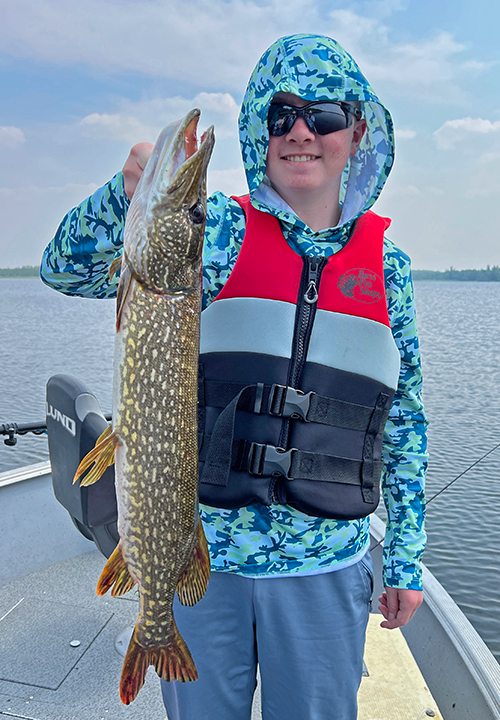 Trolling put us in and out of the spot in a few seconds, and once we passed by, not much else happened. So, I re-positioned, spot-locked the boat and rigged up 1/16-ounce jigs, tipped them with minnows, and clipped on some bobbers. The slower, more precise presentation produced a couple more crappies, but didn’t hold up. Either there weren’t a lot of fish there, or they preferred the trolling presentation vs the stationary one.
Trolling put us in and out of the spot in a few seconds, and once we passed by, not much else happened. So, I re-positioned, spot-locked the boat and rigged up 1/16-ounce jigs, tipped them with minnows, and clipped on some bobbers. The slower, more precise presentation produced a couple more crappies, but didn’t hold up. Either there weren’t a lot of fish there, or they preferred the trolling presentation vs the stationary one.
We moved along, went back to trolling and began catching fish again. Now though, the primary species were sunfish, and they were deep inside the weeds. The presentation worked fine for Patrick, Lucy’s dad, and for me too when I had time to fish. Lucy though had trouble keeping the spinner running clean in the weeds, and getting the fish hooked when they struck was tricky for her too. So, I re-positioned, spot-locked the boat and rigged up 1/16-ounce jigs, tipped them with cut pieces of night crawlers, and clipped on some bobbers.
The slower, more precise presentation produced almost nothing. For reasons known only to those sunfish, “slow, and precise” was not making them happy. I haven’t really seen that happen with sunfish before, but the “Bull in a China shop”, spinner presentation plowing through the weeds was just what they wanted, and that was that.
At midday, the scheduled crew change presented a new conundrum. Grandpa Gary and 12-year-old grandson Landry were interested in catching a larger pike. I had a plan that I hoped would work, but it would require a change of lakes.
The move brought us to a lake that has a lot of crappies, and other panfish too, but only a moderate population of northern pike. You might recall that last summer, I wrote about my “working theory” that lakes like these can provide above average size pike. As you can see from the image, it did work out for Landry on this trip. His 28-inch northern pike was the largest of our afternoon, and also, his personal best to date.
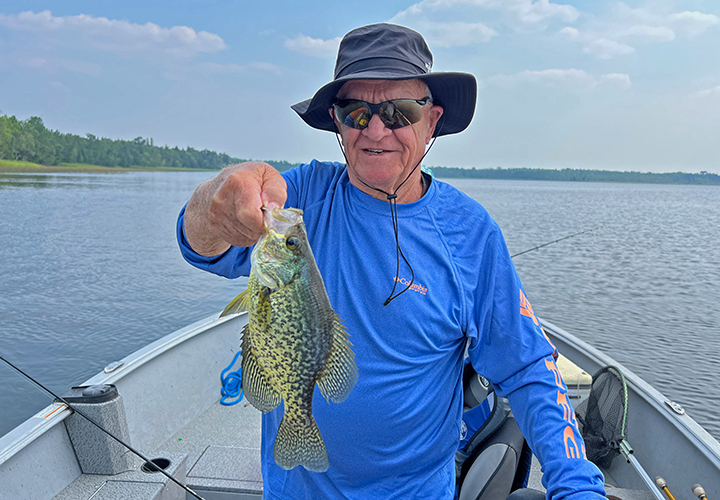 Anglers with higher skill levels may prefer casting artificial lures to catch northern pike on lakes like these. Our presentation though, trolling with spinners tipped with fatheads works very well in situations like these. The simplicity levels the playing field for kids and less experienced anglers. In this instance, it made possible Landry’s 100% pure effort to catch the targeted fish without the aid of anybody. He did it all, baited the hook, mad the cast, hooked the fish and boated it; all unassisted accept for the final netting of the fish.
Anglers with higher skill levels may prefer casting artificial lures to catch northern pike on lakes like these. Our presentation though, trolling with spinners tipped with fatheads works very well in situations like these. The simplicity levels the playing field for kids and less experienced anglers. In this instance, it made possible Landry’s 100% pure effort to catch the targeted fish without the aid of anybody. He did it all, baited the hook, mad the cast, hooked the fish and boated it; all unassisted accept for the final netting of the fish.
As a bonus, trolling spinners in situations like this one produces the desirable by catching some nice crappies, bass, and walleyes. As you can see, Grandpa Gary specialized in the crappies while Landry worked on his goal of catching northern pike.
Today, these guys have me working on a completely new and different project. For the first time in over 40 years, I have been issued my first work order to pursue and hopefully catch Lake Trout. That’s right, I’ve never guided a single date for lakers, and while I have some ideas, it represents a big experiment. Whether we succeed or not, I’ll let you know tomorrow what we do and how we do it. Then you can either congratulate us, or give us the Monday morning quarterback treatment. I’ll be ready either way!
Finally, I want to thank everyone who texted me yesterday with ideas for getting my garden tiller fixed. You are the greatest! There were so many referrals that I didn’t have time to follow up on all of them. But I have some free time coming up, and I’ll let you know how it all works out. ![]() — Jeff Sundin, The Early Bird Fishing Guide Office Cell Call or Text 218-245-9858 or Email on Facebook on X
— Jeff Sundin, The Early Bird Fishing Guide Office Cell Call or Text 218-245-9858 or Email on Facebook on X
 July 30, 2025 "Fructification of Area Lakes Forces Fish Shuffle"
July 30, 2025 "Fructification of Area Lakes Forces Fish Shuffle"
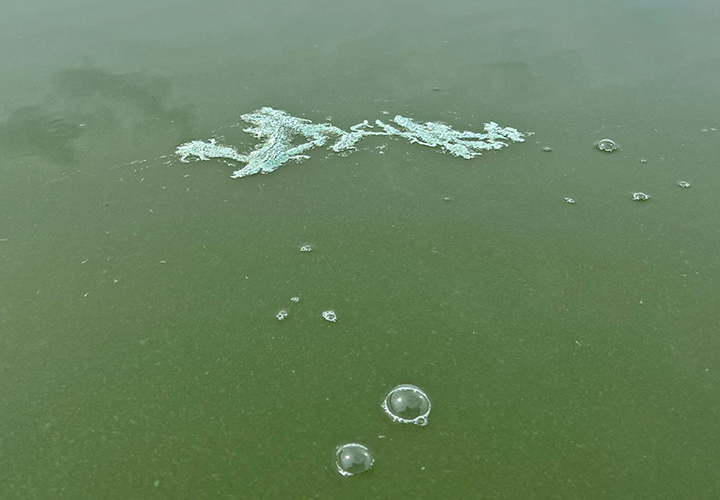 Recently heavy rains have flooded the backwaters, and many small creeks and rivers are over-flowing their banks. Now, boat ramps at shallow water, river fed lakes that were recently inaccessible, can be used by anglers with larger boats, or who have bunk trailers. While the inflow of water is welcome, it is also bringing about changes in habitat that may affect fishing patterns for your upcoming trip.
Recently heavy rains have flooded the backwaters, and many small creeks and rivers are over-flowing their banks. Now, boat ramps at shallow water, river fed lakes that were recently inaccessible, can be used by anglers with larger boats, or who have bunk trailers. While the inflow of water is welcome, it is also bringing about changes in habitat that may affect fishing patterns for your upcoming trip.
Shuffle, the term used when re-mixing a music list, or jumbling up a deck of cards, came to my mind yesterday. That’s because as water levels have risen, fish are moving away from certain terrains and choosing to re-assemble into many of their “preferred habitats”.
Water levels themselves are reason enough for the relocation of certain fish species. But another influencing factor is the fructification of the water. Inflow from shallow backwaters is warmer and supercharged with nutrients. Combined with sunshine and calm water, area lakes that were semi-clear just a few days ago are now green and soupy. Water temperatures have risen dramatically, hitting 83 degrees on Tuesday, and water clarity is severely reduced. In some cases water clarity can now be measured in inches, rather than feet. On Bowstring Lake this Tuesday, patches of toxic blue green algae were floating on the surface in one corner of the lake as well.
A while back, I advanced a theory that bullheads, redhorse suckers, dogfish and other shallow water species were being found in open water habitats, far from their typical, shallow water habitats. Now, those fish species are turning up back in shallow water, and have moved away from deeper, main lake breaklines and the like.
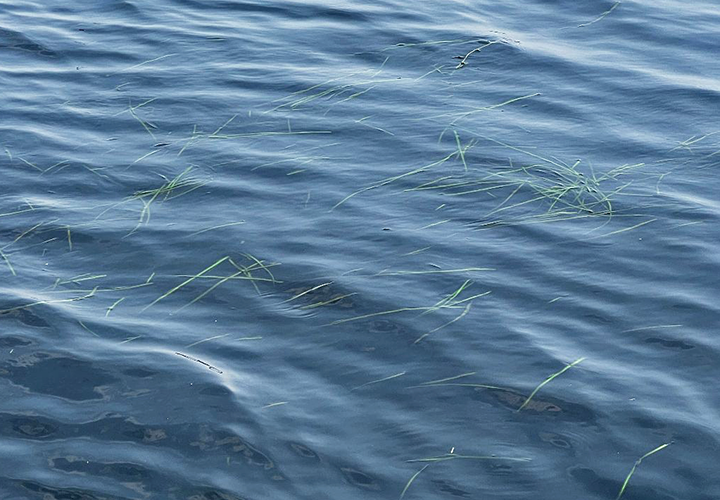 Again, on Bowstring, we caught bullheads in the weeds and could see numerous dogfish swirling on the surface in water depths of 2 to 4 feet. Sunfish disappeared from deeper weed edges and were buried deep in vegetation. The ripped-up eelgrass you see pictured here was the result of reeling in a bluegill from about 5 feet of water.
Again, on Bowstring, we caught bullheads in the weeds and could see numerous dogfish swirling on the surface in water depths of 2 to 4 feet. Sunfish disappeared from deeper weed edges and were buried deep in vegetation. The ripped-up eelgrass you see pictured here was the result of reeling in a bluegill from about 5 feet of water.
Walleyes, early in the re-organizing process had moved into the weeds too. Last Friday, we found them in about 6 feet of water, amongst the cabbage plants. Yesterday, walleyes were near the weeds, but no longer in them. Instead, they were found along the breaklines, in about 10 feet of water where there was a clean lip, or so-called feeding shelf adjacent to the steeper breakline into deep water.
There were times on Tuesday when I felt like the water was too murky. The strike window made smaller by the reduced clarity of the water meant that our lures needed to be brought closer to the fish to illicit a strike. At one point, we abandoned the spinners and fished with live bait jigs and either minnows, or night crawlers. The slower presentation helped us catch some perch but didn’t trigger any walleyes. So, we went back to trolling, and picked off fish one-by-one, leaving a lot of un-caught fish that I’d spotted on the screen of my graph.
By days end, we had a respectable catch, a mix of walleyes, sunfish, perch and a few rock bass. Northern pike, conspicuously absent from the mix were likely hole up in whatever cooler spots they could find. In the past, I’ve mentioned a condition called warm water stress. During mid-summer, pike sometimes go into a semi-dormant state when the water temperatures get too high. Most folks wouldn’t care if the pike are biting or not, but when you’re hoping to catch some, it can be disappointing.
Today, I’m going to try and fix the disappearing pike problem by staying away from all the shallow, warm, dark water lakes. Instead, we’ll be trying out some of the more moderately clear waters in the Grand Rapids area. With warmer water temperatures, and heavier weed growth, we should be able to produce a mixed bag of panfish, crappies and bass. If I get lucky, we’ll stumble into a few walleyes along the way too. Whatever happens, I’ll have an update for you tomorrow morning.
Before I go, I need to ask a favor. If you know about a small repair shop that can repair the transmission of my garden tiller, I’d appreciate knowing about it. The popular fleet supply store that sold it to me took one look at it and said that they can’t fix it. So, I need to locate a smaller operation, one with a staff who can devote a little time to examine the problem. ![]() — Jeff Sundin, The Early Bird Fishing Guide Office Cell Call or Text 218-245-9858 or Email on Facebook on X
— Jeff Sundin, The Early Bird Fishing Guide Office Cell Call or Text 218-245-9858 or Email on Facebook on X
 Ely Area, Arrowhead Outdoors Fishing Report July 30, 2025
Ely Area, Arrowhead Outdoors Fishing Report July 30, 2025
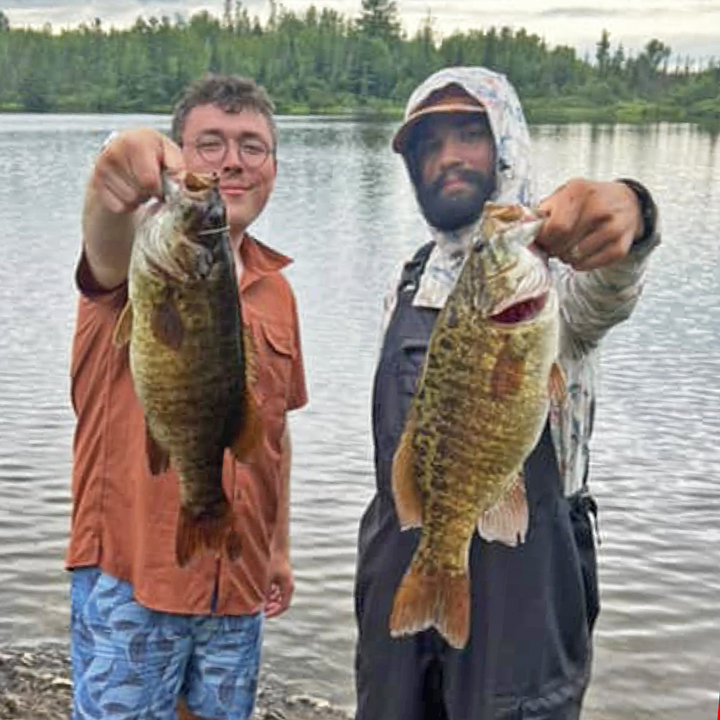 "Walleye - Heavy rains, high pressure and bluebird skies left many anglers struggling just to get a bite. Still many anglers adapted and kept catching fish.
"Walleye - Heavy rains, high pressure and bluebird skies left many anglers struggling just to get a bite. Still many anglers adapted and kept catching fish.
Anglers have been reporting that walleyes seemed to be transitioning more and more to large mud and sand flats. When this starts, trolling crankbaits with leadcore fishing line, in 15 to 25 feet of water, is the best way to keep bringing fishing into the boat. Small perch colored crankbaits have been really hot. The deep water trolling bite also has started on many area lakes. Here anglers are trolling for suspended walleyes over 35 to 80 feet of water. These walleyes are chasing ciscos during the last hour of daylight and are often caught 15 to 20 feet down. Here white, silver/blue and blood nose have been effective colors.
Trolling not your thing? Try pulling spinner rigs in gold, perch and orange, tipped with a crawler or leech, in 10 to 15 feet of water. Anglers fishing around sunken islands, weedlines and points, continue to catch walleyes. There were several reports this last week from anglers catching walleyes right off their campsites after dinner. Jig and half a crawler, jig/twister and paddle tails all were very effective here.
Smallmouth Bass - Smallies continue to be easy pickings for many anglers whether you're targeting them or not. Early morning topwater bite remains strong for anglers. As the water temps start rising smallies start dropping down looking for cooler water. Shallow points, sunken islands or flats with deep water close by, have been the best areas for catching smallies. Squarebills, wacky worms, chatterbaits and spinnerbaits have all been very effective once the sun gets up.
Panfish - How shallow is too shallow for crappies? Based off recent reports from crappie anglers, 1 foot of water is the answer. Many anglers have reported they are catching really nice crappies in 1 to 3 feet of water, in thick weeds or lily pads. Jig/twister has been getting the job done here for anglers. Anglers have also been reporting that sunfish are also being located in shallow water, but not as shallow as the crappies. Sunnies are being caught in 3 to 6 feet of water, right in thick weedbeds too. Wax worms, angleworms and green crawlers, fished under a bobber have been very effective on sunnies.
Stream Trout - Stream trout anglers continue to report some great fishing for rainbows. Small copper backed trolling spoons were very effective on local stream trout lakes this last week. Anglers have been using either leadcore or lead weights to get these lightweight spoons down 10 to 20 feet of water. Anglers fishing from shore have been having good luck simply floating a night crawler off the bottom 2 to 3 feet.
Northern Pike - Hot weather cooled off any reports of pike over 30 inches. While small pike are easy to find in any shallow weedbeds, river mouths or mouth of shallow bays with small spoons, spinnerbaits and buzzbaits, larger pike are being found in these same areas, but with access to deep water. Larger spoons, large minnow baits and large spinners have been more effective for these pike.
Lake trout - High winds and high temperatures limited reports from lake trout anglers this last week. Warming water temps have the thermocline setting up nicely at 30 to 40 feet. Active lake trout are being caught close to this line with large trolling spoons." — Arrowhead Outdoors, 218-365-5358
 Wired2Fish July 30, 2025 "Go Deep For Big Summertime Bluegills"
Wired2Fish July 30, 2025 "Go Deep For Big Summertime Bluegills"
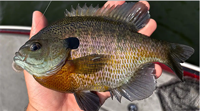 "Let’s face it — the bluegills off the dock of your family’s cottage have gotten smaller and smaller as summer goes on. The water has warmed up, weeds fill the shallows, and not a big bluegill in sight. Small bluegills gather at the tip of the dock, but the big ones are almost nonexistent. Where could they have possibly gone? They were around earlier in the year and can’t be that far, right?
"Let’s face it — the bluegills off the dock of your family’s cottage have gotten smaller and smaller as summer goes on. The water has warmed up, weeds fill the shallows, and not a big bluegill in sight. Small bluegills gather at the tip of the dock, but the big ones are almost nonexistent. Where could they have possibly gone? They were around earlier in the year and can’t be that far, right?
Like bass, bull bluegills get into a post-spawn funk around midsummer. Then, they proceed to one place. And that’s deep water you likely can’t reach with a cast from your dock. But why are they going there? What drives them to stay deep in the summertime? Aren’t they supposed to be shallow? Here’s how to target and consistently catch big bluegills in the ..." View Video to Learn More >> Go Deep For Big Summertime Bluegills
 Lake of the Woods, LOW Tourism July 30, 2025
Lake of the Woods, LOW Tourism July 30, 2025
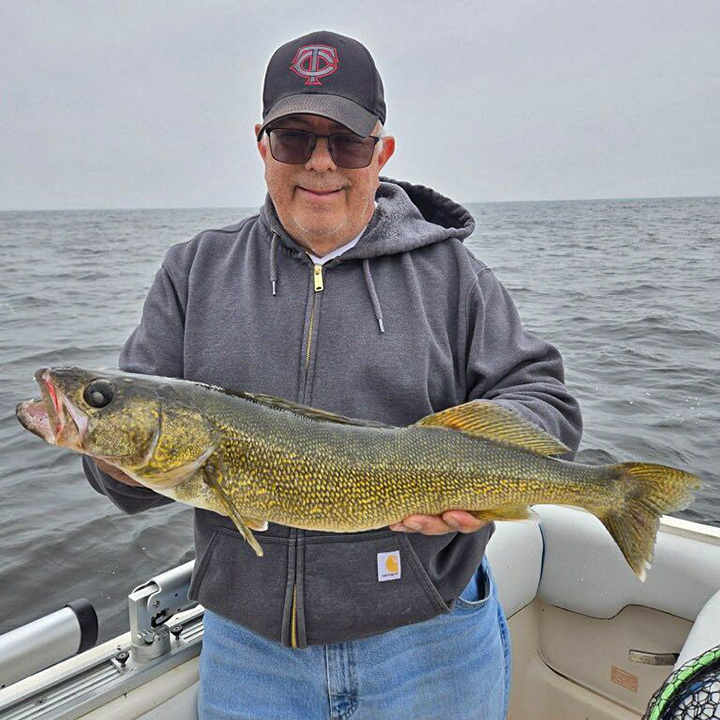 "Deep summer fishing patterns continue to dominate the walleye bite on the south end of Lake of the Woods. Throughout the past week, the action has remained excellent. Anglers are having consistent success using three different techniques — spinner rigs with crawlers, trolling crankbaits, and even jigging, which is impressively still producing.
"Deep summer fishing patterns continue to dominate the walleye bite on the south end of Lake of the Woods. Throughout the past week, the action has remained excellent. Anglers are having consistent success using three different techniques — spinner rigs with crawlers, trolling crankbaits, and even jigging, which is impressively still producing.
Most anglers are pulling crawler harnesses over the expansive mud basin of Big Traverse Bay. Depths of 25 to 35 feet have been the sweet spot. Drifting or trolling at 1.0 to 1.25 mph has been the ticket for connecting with numbers of eater-size walleyes and saugers, as well as the occasional big slot fish (19.5 to 28 inches), which must be released.
Hot Spinner Colors: Gold continues to be the go-to, with gold/orange, gold/pink, and gold/glow red all producing well in the stained water.
Trolling crankbaits is also putting good fish in the boat, especially for those looking to cover water and target scattered schools of walleyes. The best crankbait colors remain the classics — firetiger, pink UV firetiger, chartreuse, chrome/blue, and of course, gold.
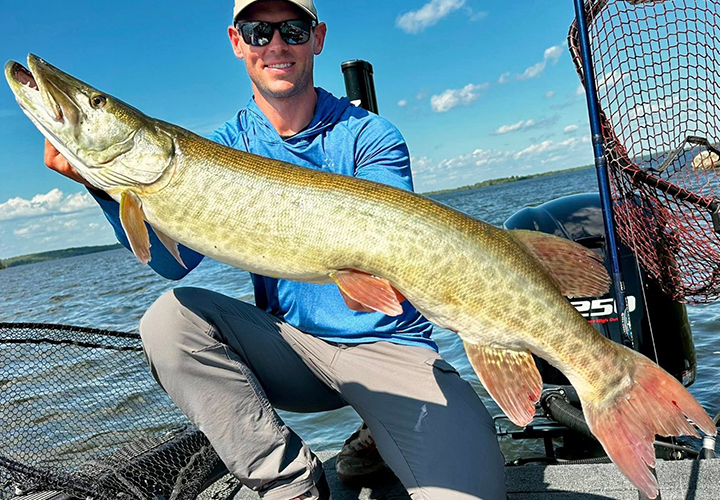 While many anglers shift away from jigging in late July, some are still finding success by vertical jigging with frozen emerald shiners. It’s been a unique season where all three techniques — spinners, crankbaits, and jigs — are continuing to produce solid results.
While many anglers shift away from jigging in late July, some are still finding success by vertical jigging with frozen emerald shiners. It’s been a unique season where all three techniques — spinners, crankbaits, and jigs — are continuing to produce solid results.
The Rainy River offers a quieter alternative to fishing on the big lake and is a great place to fish, especially on days when the wind whips up. A variety of species are being caught, and the sturgeon “keep” season is in full swing through September. Anglers targeting sturgeon are using circle hooks baited with crawlers or frozen emerald shiners and fishing deep holes or current seams.
In addition to sturgeon, it’s common to catch walleyes, saugers, suckers, smallmouth bass, or northern pike while soaking bait on the bottom. With lighter boat traffic and beautiful scenery, it’s an enjoyable place to kick back and bend a rod.
Up at the Northwest Angle, fishing remains excellent at the Northwest Angle, with walleyes being caught using a variety of methods. Anglers are jigging with minnows or plastics around structure like sunken islands, points, and neck-down areas. Others are pulling crawler harnesses with bottom bouncers over mud or along transitions from mud to rock.
This part of the lake also offers great multi-species action. Northern pike, jumbo perch, smallmouth bass, and even crappies are providing bonus bites. And with rising water temps, the muskie bite is strong as well." — Lake of the Woods Tourism, (800) 382-FISH
 July 29, 2025 "A Really Good Day To Be Landry"
July 29, 2025 "A Really Good Day To Be Landry"
 It’s always a good day for everybody who is lucky enough to be fishing. But there are days when one person seems to be singled out to receive a particularly “lucky day”. That’s how yesterday worked out for young Mr. Landry Patterson who had a particularly good morning on the lake. His good luck was my good luck too because some of the fish we caught were attributed to simply being in the right place, at the right time; more on that later.
It’s always a good day for everybody who is lucky enough to be fishing. But there are days when one person seems to be singled out to receive a particularly “lucky day”. That’s how yesterday worked out for young Mr. Landry Patterson who had a particularly good morning on the lake. His good luck was my good luck too because some of the fish we caught were attributed to simply being in the right place, at the right time; more on that later.
Conditions on the lake were not ideal, the water was calm, and the sun was shining brightly. Surface temperatures in the shallow, dark water were 78 degrees when we started fishing and would eventually rise to 83 degrees in protected areas. Over mid-lake structures, temperatures stayed cooler, ranging between 75 and 79 degrees throughout the day.
I’d fished at the lake last Friday so based on what happened that day, I had a few ideas about where to look. Right off the bat, the shallow, 6-foot-deep weedy point where we started provided Landry with the first walleye of the day. Not long afterward, his spinner, a #4 hammered copper Indiana blade, with a single 2/0 Aberdeen hook, tipped with a fathead was snapped up by a nice sunfish. Then there were some northern pike, and then the spot dried up.
A move to another shallow, 3-to-6-foot deep breakline provided some panfish action, I think we caught 2 or 3 more nice sunfish on the first trolling pass. I noticed though that our spinners were only struck when they passed through the heavier patches of submerged weeds. As an experiment, we stashed the spinners and pulled out the jigging rods. I set them up with 1/8-ounce live bait jigs, added a clip-on foam float set to about 4 feet and tipped the jigs with chunks of night crawlers.
 Spot-locked within casting distance of the weeds, we pitched our lures into the vegetation and wound up catching 8 or 10 more sunfish, and quite a few rock bass. If not for the action slowing down, we’d likely have finished out the morning right there, without searching for any other fish. But the slow down provided incentive to make a move, which in turn, led to another “lucky break”.
Spot-locked within casting distance of the weeds, we pitched our lures into the vegetation and wound up catching 8 or 10 more sunfish, and quite a few rock bass. If not for the action slowing down, we’d likely have finished out the morning right there, without searching for any other fish. But the slow down provided incentive to make a move, which in turn, led to another “lucky break”.
This time we stashed the jigging rods, pulled out the spinners again and added some extra weight. I pulled up to a narrow rock flat that tops off at about 14 feet of water and began a trolling pass over the rock tops. Long story short, there was a school of walleyes holding there and Landry’s dad, Patrick pulled in a couple of them, I caught one too and the young lad Landry caught 3 of them, not a bad morning.
Interrupting our photo shoot of Landry’s largest one, was a call from grandpa, Gary, who was at the landing, ready for the midday crew swap that we’d set up in advance. So, we headed back to the landing, picked up Gary and his 8-year-old granddaughter Lucy. Naturally, after seeing the morning catch, the afternoon crew was excited about their prospects for a good afternoon.
Motoring back to the “walleye hole”, we picked up where the morning crew left off, and Lucy did get to reel in one walleye there, but that was the end of that. There were a few more nice sunfish caught during the afternoon too, but the pecking order was different now. Northern pike, mostly small ones had become very active and while they provided a lot of action, did not provide any more fish for the Patterson family larder. Still, despite the sunshine, warm water and sunshine, 8 walleyes, 14 sunfish and a rock bass would be more than enough to provide a full-scale family fish fry back at camp.
The single rock bass, kept at the insistence of Landry may turn out to be the beginning of something beautiful. I know a lot of you will turn up your noses, but believe it or not, rock bass have a lot of fans out there. Some of my customers happily take them home, especially when the fish are big and beautiful looking like the ones we found yesterday were. If their reaction to the test fish turns out the same as it often does, I may be cleaning more rock bass on Wednesday, when I fish with the Patterson family again.
Okay, so in the words of one reader, “if you’re lucky enough to be fishing, you’re lucky enough.” Yesterday, we were all lucky enough, and for young Landry, being in the right place at the right time, added up to being really, really, lucky!
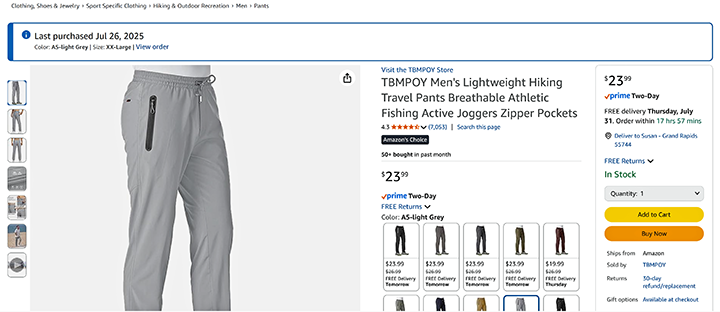 Finally, I want to wrap up this morning with a suggestion for you. Flies, like the deer flies we encountered yesterday can ruin a fun day on the lake, especially if you dress fashionably, as did young Landry yesterday. In the past, I’ve suggested using the Avon product, Skin So Soft Expedition Formula to keep flies away from ankles and other sensitive areas. That product still works very well, but the expense, and sometimes lack of availability encouraged me to make a change. Instead of fighting the biting flies with sprays, I decided to try wearing ultra-light weight, long pants, and I love them!
Finally, I want to wrap up this morning with a suggestion for you. Flies, like the deer flies we encountered yesterday can ruin a fun day on the lake, especially if you dress fashionably, as did young Landry yesterday. In the past, I’ve suggested using the Avon product, Skin So Soft Expedition Formula to keep flies away from ankles and other sensitive areas. That product still works very well, but the expense, and sometimes lack of availability encouraged me to make a change. Instead of fighting the biting flies with sprays, I decided to try wearing ultra-light weight, long pants, and I love them!
Nobody sponsors me, and there will be no compensation of any kind for this recommendation, so understand that it comes from the heart. The TBMPOY Men's Lightweight Hiking Travel Pants that I picked up a couple of years ago are fabulous for keeping the flies off of my angles. They are extremely lightweight, so I don’t sweat much in them, even on hot sunny days like yesterday. At $24, a pair of these pants is actually less expensive than a single can of the bug spray that I used to buy. I have been so happy with these pants that I have re-ordered several times, including another re-order just a few days ago.
Besides protecting me from bugs, the pants are so light that they dry quickly, making them perfect for days when the water is choppy, and waves splash over the gunwales, when there are occasional light sprinkles. One caveat will not keep you warm on cooler days, so you’ll need to use them as a base layer, under rain pants or bibs during cooler weather. Like I said though, if the primary concern is fighting the battle against biting flies, these pants will do the trick. ![]() — Jeff Sundin, The Early Bird Fishing Guide Office Cell Call or Text 218-245-9858 or Email on Facebook on X
— Jeff Sundin, The Early Bird Fishing Guide Office Cell Call or Text 218-245-9858 or Email on Facebook on X
 July 28, 2025 "In the Hot-Seat, Re-Thinking the Think-Able"
July 28, 2025 "In the Hot-Seat, Re-Thinking the Think-Able"
 During the wee hours this morning, as I threw away leeches and night crawlers that perished from yesterday’s heat, I find myself re-thinking my report from July 22, 2025 when I wrote, “The most important observation from both lakes was the water temperature. At 71 to 72 degrees, they are fully 5 to 6 degrees cooler than they were just a couple of weeks ago. It is highly likely that the warmest water temperatures of the summer have come and gone.” There was more to the statement than that, including the advisory, “I know, there will still be some warm weather, and temps will rebound a little bit, I’ll be following the trajectory …”
During the wee hours this morning, as I threw away leeches and night crawlers that perished from yesterday’s heat, I find myself re-thinking my report from July 22, 2025 when I wrote, “The most important observation from both lakes was the water temperature. At 71 to 72 degrees, they are fully 5 to 6 degrees cooler than they were just a couple of weeks ago. It is highly likely that the warmest water temperatures of the summer have come and gone.” There was more to the statement than that, including the advisory, “I know, there will still be some warm weather, and temps will rebound a little bit, I’ll be following the trajectory …”
Okay, there has been warmer weather late last week, and on Sunday, we kicked off a new week with a heat wave in the Grand Rapids area. Surface water temperatures were on the rise again, and finding temps in the mid-70s on clear water lakes was easy again. On shallow, darker water lakes, some temperatures rose higher, reaching the 78-degree range in some areas. It won’t be easy for water temperatures to hold overnight, and looking at the forecast, cooler daytime high air temperatures are forecast. At the same time though, sunshine and calm seas are also predicted, so there is potential for daily warming to occur.
This is one time that I’d be happy to be wrong because warm water raises fish metabolism, making the mixed bag action bite a great option for the week. Beyond that, sunny conditions will also increase the algae blooms on area lakes, and that provides food for tiny fish, and diminishes water clarity at the same time. Often, as we roll into August, shallow water, weedline fishing strategies become highly productive, and that would be great news for anglers in our region.
So today, I’ll be in the hot seat, hopefully happily, as I attempt to keep the Patterson clan entertained with a mixed-bag trolling bite. Tomorrow, I’ll let you know how it goes, so check out the report.
On one of my recent charters, I casually asked members of my crew, “have you taken advantage of the opportunity to voice your opinions about the proposal to reduce Minnesota’s walleye possession limit?” I looked into it, but when I clicked on the link to participate in the survey, it wanted to take me off of the main website, and onto another one, so I gave up,” one man said.
When I told him that I’d taken the survey, and that it took me about 10 minutes to complete, he replied that he wasn’t planning to spend the time on it. That’s okay, and it is absolutely his, and your right not to participate. But if you have an opinion, and you don’t share it, then plan to be happy with whatever the final plan turns out to be. The survey aimed at gathering public opinion before the rules change is formally introduced represents the last chance to shape, or edit the rule that will be put forward, and theoretically implemented by the Minnesota DNR.
In reading the Lake Winnie report from Bowen Lodge last Friday, a noticed a note from the retired MN DNR large lake specialist for Winnibigoshish, Gerry Albert. Albert advised that the fisheries survey that expires on August 15, 2025, is not the final step in the public comment process. In fact, according to Albert, the official comment period will not begin until after the rule change is formally announced by MN DNR.
I can’t think of any process that’s taken longer or has been more widely anticipated than this one. But, I’ll be following the rules change and the process step-by-step, then I’ll keep you posted about your opportunity to provide comments, or not, as you see fit. ![]() — Jeff Sundin, The Early Bird Fishing Guide Office Cell Call or Text 218-245-9858 or Email on Facebook on X
— Jeff Sundin, The Early Bird Fishing Guide Office Cell Call or Text 218-245-9858 or Email on Facebook on X
 July 27, 2025 "Sundin's Big Sandy Busman's Holiday"
July 27, 2025 "Sundin's Big Sandy Busman's Holiday"
 My “highlight reel” for the 2025 fishing season now includes fishing with 2 of my favorite people, on 1 of my favorite lakes, Big Sandy.
My “highlight reel” for the 2025 fishing season now includes fishing with 2 of my favorite people, on 1 of my favorite lakes, Big Sandy.
I think it’s been 11, maybe 12 years since my daughter, Katie (Sundin) Marchev spent a day in the boat with me and even longer since the last time she shared a fishing date with “Grampy”, Carl Bergquist. So, naturally I bent over backwards to accommodate her request to set a date for a reunion. That date was yesterday 7-26-25 and the location, Big Sandy was intended to shorten Katie’s travel time for a day trip up north. The fish we caught were welcome but really were just icing on the cake.
My fishing report could not be complete without first thanking the AIS inspector lady who greeted us at the boat ramp. During the inspection, I asked if there were any good fishing reports. With eyebrows furled, and a stern look on her face she said, “ooh, I don’t know, it’s been pretty slow out there, not many people coming in with fish. But at least you have a nice day to be on the lake.”
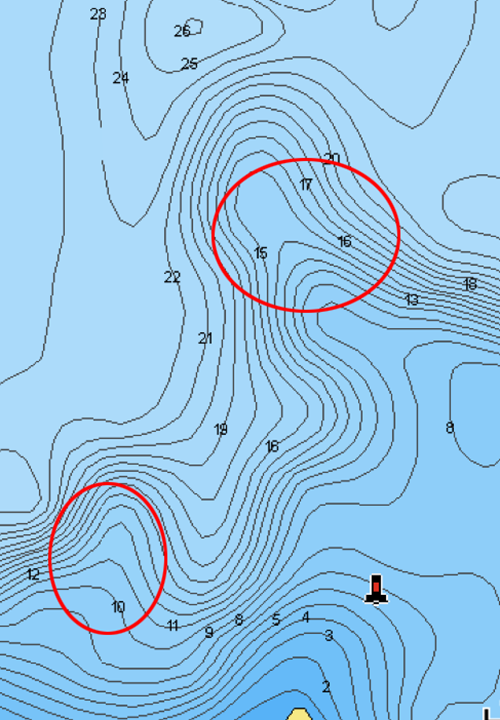 Don’t ask me why, but that’s my favorite answer! I know it’s a silly superstition, but it seems like whenever anybody tells me how slow fishing is, and how hard I’ll have to work, I do better than whenever they report how great fishing has been. It doesn’t always mean that we’ll catch fish hand over fist, but like yesterday, the lake usually gives us something to smile about.
Don’t ask me why, but that’s my favorite answer! I know it’s a silly superstition, but it seems like whenever anybody tells me how slow fishing is, and how hard I’ll have to work, I do better than whenever they report how great fishing has been. It doesn’t always mean that we’ll catch fish hand over fist, but like yesterday, the lake usually gives us something to smile about.
Technically, the report is a simple one. Surface water temperatures varied around the lake, and ranged between 71 degrees on the main, windswept areas, vs 75 degrees in protected bays and calm areas. The water level was good, and the flow from the Mississippi River was strong. At Jacobson, for example, the riverbed was full, and slightly over its banks.
Fish were scattered, like they have been on many lakes this summer. But when encountered, they were active and usually a sighting on my graph equaled a strike. Most of them were located on the tips of shoreline points, or on some of the lakes submerged bars. We caught some fish on structures with rocks, and we also caught fish on structures with softer, sand-marl mixtures. There were some walleyes on both, but rockier places seemed to have more pike than walleyes, and softer bottom areas held more perch than walleyes.
Our presentation, trolling #4 hammered copper spinners behind ¼ ounce bullet sinkers worked well for the depths we fished. Most sightings occurred from about 10 feet, down to about 14 feet of water. The ¼ ounce weights got snagged occasionally in the shallower range, but not at the deeper end of the range. Fathead minnows was the primary bait, but I offered night crawlers at times too. Both baits worked, but fatheads became the main offering since they were simpler, cleaner and less expensive to use.
The action was slow-but-steady, we rarely waited more than 10 minutes between strikes. But if you know Big Sandy, then you know that many of the fish were small. Numerous fish in the 10 to 12 inch range were caught, a few just below the keeper size range,13 to 13-1/2 inches, and just enough “keepers” to provide Katie a few walleye meals to share with our son-in-law, Ivan. One of the northern pike we caught measured 27 inches, so a bonus meal of coconut pike delight will be on Katie’s meal schedule soon too.
 I’m sorry, the time slipped away before I checked out any of Big Sandy’s weedy spots. So, I’m not sure if there were active walleyes, panfish or perch in the shallow water. I do suspect that there may be though. That’s because other lakes in my region with similar shallow water vegetation are beginning to produce.
I’m sorry, the time slipped away before I checked out any of Big Sandy’s weedy spots. So, I’m not sure if there were active walleyes, panfish or perch in the shallow water. I do suspect that there may be though. That’s because other lakes in my region with similar shallow water vegetation are beginning to produce.
Thanks to recent rainfall, water levels on lakes like Bowstring, Splithand and others have been on the rise. As the water floods over the shallow vegetation, fish of all species are moving in. On Friday, we caught a mix of pike, perch, bluegills and walleyes by trolling in the shallow weeds. Key depths ranged from 5 to 7 feet, with the sweet spot occurring at about 6 feet of water. So, if you’re fishing this week, and the lake has a mixture of weeds along the shallow, shoreline breaks, take a few passes with spinners to gauge the action for yourself.
Finally, I don’t think the ratio of keepers was high enough for me to return to Big Sandy for an official, big time guide trip. But for me, yesterday’s busman’s holiday on Big Sandy could not have worked out better. Maybe if you’re after a relaxing family day that ends with a family fish fry, like the one Katie fixed last night, I think you should be able to make that happen. ![]() — Jeff Sundin, The Early Bird Fishing Guide Office Cell Call or Text 218-245-9858 or Email on Facebook on X
— Jeff Sundin, The Early Bird Fishing Guide Office Cell Call or Text 218-245-9858 or Email on Facebook on X
 Cutfoot Sioux, Lake Winnie Memorial Day Fishing Report July 25, 2025
Cutfoot Sioux, Lake Winnie Memorial Day Fishing Report July 25, 2025
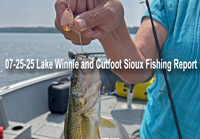 "The news of the week on both Lake Winnie and Cutfoot Sioux are the heavy rains that saturated bogs, and backwater lowlands. As a result, there has been a steady increase in the flow of water from small reivers and streams. With the increase in warmer, nutrient rich water flow comes a decrease in water clarity.
"The news of the week on both Lake Winnie and Cutfoot Sioux are the heavy rains that saturated bogs, and backwater lowlands. As a result, there has been a steady increase in the flow of water from small reivers and streams. With the increase in warmer, nutrient rich water flow comes a decrease in water clarity.
The Secchi disk reading, taken offshore near Raven’s Point on Thursday was 11 feet. Still clear by historic standards, the 11-foot reading represents a full 50% reduction from the 22-foot water clarity we reported back in early June 2025. That’s good news for anglers who have battled ‘boat shy” walleyes, pike and panfish. Reports of sighting fish on electronics, and catching them, in shallow 10-to-12-foot water depths is encouraging.
In the aftermath of thunderstorms that affected our region on Wednesday, perch, pike and walleye action was sluggish. That said, there were still some “catchable fish” and that’s a good sign, we think. If fish bite on the days when they’re not supposed too, action is more likely to be good when we ..." Read >> July 25, 2025 Bowen Lodge Lake Winnie Fishing Report
 July 24, 2025 "Servicing the Service-Able"
July 24, 2025 "Servicing the Service-Able"
After my fishing date on Monday, Tuesday was blocked off the calendar for routine maintenance of my outboard motor. Fresh spark plugs, impeller, water pump and an oil change aimed at keeping business running smoothly. While Jason Milroy at Ray’s Marine got that project take care of, I threw 2 of my broken trolling motors in the truck and dropped them off in Walker, MN for service. By the time I got home and had a little lunch, the boat was ready and I picked her up, cleaned her up, and prepared for my fishing trip on Wednesday morning.
 After all that preparation, my trip didn’t work out as planned on Wednesday. Thunderstorms forced my first weather cancellation of the 2025 season and there was no way to go out on a research and development fishing date. So, with our windfall of free time, I and the Hippie Chick planned to begin chipping away at our remaining list of maintenance issues. Clean up the air conditioner, pick up the broken garden tiller, fix the leaky toilet and if there is time left, maybe take a nap? That plan didn’t quite come together either, but the interruption was a happy one.
After all that preparation, my trip didn’t work out as planned on Wednesday. Thunderstorms forced my first weather cancellation of the 2025 season and there was no way to go out on a research and development fishing date. So, with our windfall of free time, I and the Hippie Chick planned to begin chipping away at our remaining list of maintenance issues. Clean up the air conditioner, pick up the broken garden tiller, fix the leaky toilet and if there is time left, maybe take a nap? That plan didn’t quite come together either, but the interruption was a happy one.
At about 10:30 am, Gary Erickson from Maxxum Rigging left me a phone message; “your trolling motors are done and ready for pickup”. Wow, 24-hour service in this day and age, that’s unheard of! I offered Susan a ride to get the electric motors and offered a stop for lunch. She took me up on the offer, so we loaded the 3rd broken trolling motor and started driving west.
At Maxxum Rigging, Gary ran me through the list of repairs, gave me some sage advice about preventing future troubles. As Erickson and I chatted, he explained how it’s possible to offer such fast turnaround times. “I try to keep almost every part for all of the more popular trolling motors in stock.” He said. “Whenever possible, I try to get the motors repaired and back out the door within a couple of days,” he added. That’s just the way Erickson operates his business, and 30 to 40 years ago, I recall that there were others who offered the same, exemplary sort of service. These days, it is the exception, not the rule and that's why I'm sharing with you.
I’d never been to Maxxum before, and I can’t take credit for the discovery. That credit goes to my friend Fritz Becker who told me about the operation earlier this summer. I’m glad he did, because Erickson’s knowledge of the products, and fast service was everything Becker said it was, and more. Now that I know about it, I will be visiting the operation whenever I need an electric trolling motor repaired. I’ll offer you the same guidance that Becker offered me, if you’re in a bind and need your trolling motor repaired, don’t hesitate. Call Gary Erickson, MAXXUM Rigging, 218-547-4877
Okay, now all I need is to find folks that are equally good at fixing air conditioning, garden tillers and weather disrupted walleye fishing spots! That’s because today, we’re back in the search for catch-able walleyes because “walleye or die” fishing trips are showing up on my schedule again over the next few days. We’re leaning toward Winnie and Cutfoot today but prepared to change the plan if it seems necessary. Expect an update about that tomorrow. ![]() — Jeff Sundin, The Early Bird Fishing Guide Office Cell Call or Text 218-245-9858 or Email on Facebook on X
— Jeff Sundin, The Early Bird Fishing Guide Office Cell Call or Text 218-245-9858 or Email on Facebook on X
 Ely Area, Arrowhead Outdoors Fishing Report July 23, 2025
Ely Area, Arrowhead Outdoors Fishing Report July 23, 2025
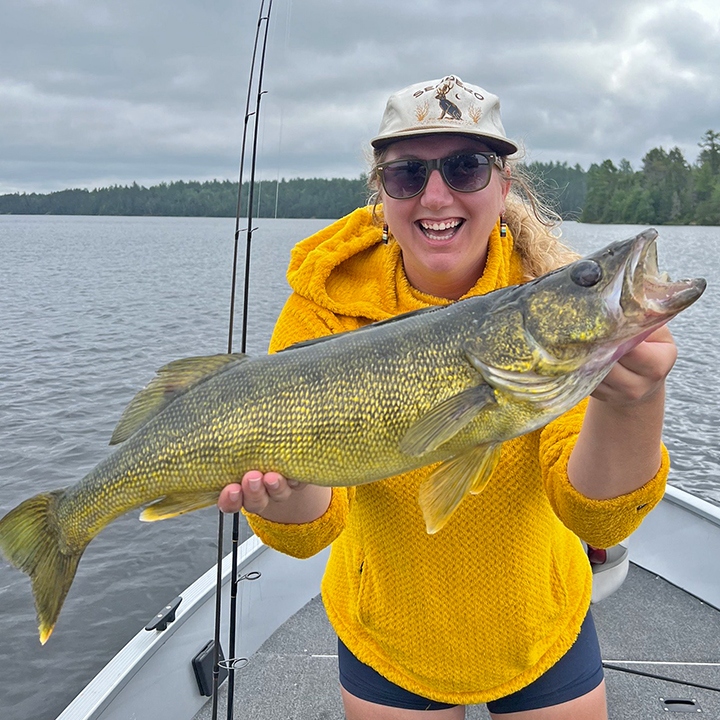 "Walleye fishing remains very good for many anglers this last week. Crawlers on a spinner rig or jig and half a crawler continue to get the job done for anglers. Many anglers are reporting 10 to 15 feet of water, along weedlines, edges of flats and on top or around sunken islands has been where anglers are finding active walleyes. Windy shorelines or exposed humps, even better. Hot colors continue to be firetiger, pink and gold.
"Walleye fishing remains very good for many anglers this last week. Crawlers on a spinner rig or jig and half a crawler continue to get the job done for anglers. Many anglers are reporting 10 to 15 feet of water, along weedlines, edges of flats and on top or around sunken islands has been where anglers are finding active walleyes. Windy shorelines or exposed humps, even better. Hot colors continue to be firetiger, pink and gold.
Smallmouth Bass fishing also continues to be very good for bass anglers. Topwater continues to be very good early in the morning. As the sun gets up anglers switch to chatterbaits, spinnerbaits, wacky worms and Ned rigs to keep catching bass. Anglers will find smallies in rivers, river mouths, downed trees, large rocky flats and out in the sunken islands in 6 to 15 feet of water. White, loon and any crawfish colors have been very effective.
Panfish - Crappies and sunfish continue to be found right inside thick weedbeds or around downed trees. Not all downed trees or weeds are created equal, so anglers will often have to check a few downed trees and weed clumps before they find the ones the fish are relating to that day or that time of day. During that last hour of light crappies have been leaving the thick cover and cruising around the weedbeds looking for minnows or bugs to eat. Regardless of the species, 2 inch twister, thumper jigs, small jigs tipped with a chunk of worm, wax worm or crappie minnows, fished under a bobber have been very effective.
Stream Trout - Rainbow trout and Splake were common catches this last week for stream trout anglers. Many anglers are catching trout simply trolling small crankbaits or small trolling spoons, over deep water and catching nice limits of trout. For both baits, the brighter the better is a good rule of thumb. Depths range from 10 to 30 feet of water. Anglers fishing from shore have been reporting that they are catching trout floating a night crawler 2 to 4 feet off the bottom.
Lake Trout - Lake Trout anglers reported a little bit of a slow week this last week. High winds and storms kept canoe anglers grounded. Boat anglers reported decent lake trout fishing trolling with down riggers and large trolling spoons. Key depths this last week continue to be caught 30 to 80 feet.
Northern Pike anglers had a good week. Cloudy, cool and rainy days are perfect days to target pike. Some nice pike in the mid 30 inch range were caught. Anglers have been having good luck throwing large swim baits, large spoons and spinnerbaits along weedlines, mouths of shallow bays and river mouths." — Arrowhead Outdoors, 218-365-5358
 Lake of the Woods, LOW Tourism July 23, 2025
Lake of the Woods, LOW Tourism July 23, 2025
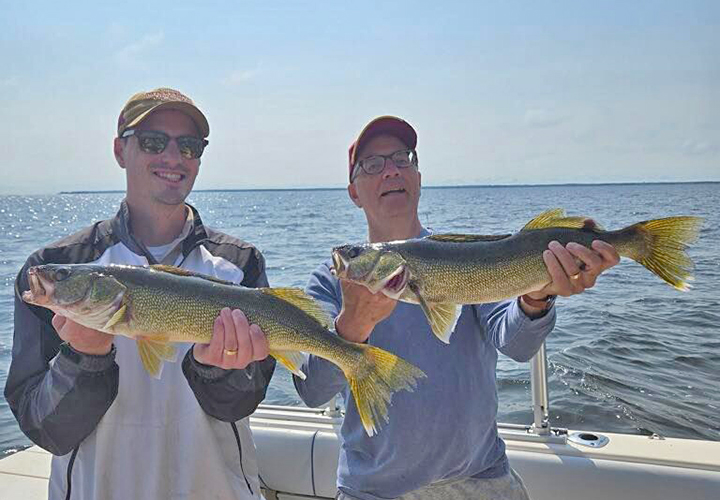 "It’s mid-July, and the summer walleye patterns are in full effect on the south side of Lake of the Woods. So, the fishing has been excellent!
"It’s mid-July, and the summer walleye patterns are in full effect on the south side of Lake of the Woods. So, the fishing has been excellent!
As expected during this time of year, most anglers are now pulling spinners with crawlers or trolling crankbaits, two proven techniques that are putting good numbers of walleyes and saugers in the boat. Reports are strong, with lots of anglers catching limits of eaters and also encountering plenty of protected “slot fish.” Slot fish are walleyes between 19.5 and 28.0 inches that must be released to protect the fishery and many of these are big, healthy, and exciting to catch. Snap a quick photo and release them so they can help produce more walleyes in the future.
Fish are being caught in a range of depths, but 25 to 35 feet over the deep mud basin of Big Traverse Bay has been especially productive.
Best Spinner Colors: Gold, gold/orange, gold/pink, and gold/glow red have been consistent producers. Troll spinners around 1.0 – 1.25 mph for best results. Best Crankbait Colors: In LOW’s stained water, classic colors are hard to beat — gold, firetiger, pink UV firetiger, chartreuse, and chrome/blue are all catching fish.
While jigging typically slows down by now, some anglers are still jigging with frozen emerald shiners and having success. This season has been unique in that all three techniques—jigging, spinner rigs, and cranks—are still getting the job done!
The Rainy River remains a great option, and also a nice backup on windy days or for those who prefer a quiet stretch of water to kick back and relax. A mixed bag of fish is common here. The sturgeon “keep” season is currently open and runs through September. Anglers can keep one sturgeon between 45 and 50 inches, or one over 75 inches per calendar year (with a tag). Many are soaking crawlers and/or frozen emerald shiners on the bottom to target these giants.
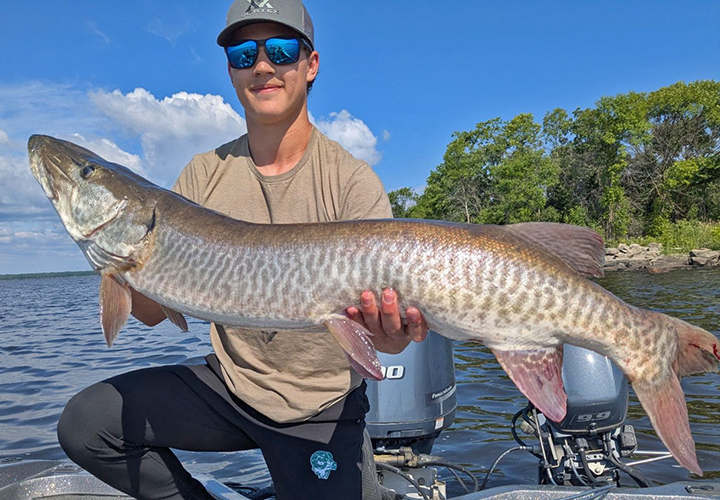 While targeting sturgeon, it’s not unusual to catch walleyes, saugers, suckers, or even a surprise smallmouth or pike. Deeper holes and current breaks are key locations to find fish on the river.
While targeting sturgeon, it’s not unusual to catch walleyes, saugers, suckers, or even a surprise smallmouth or pike. Deeper holes and current breaks are key locations to find fish on the river.
Up at the Northwest Angle, fishing continues to be very strong at the Northwest Angle, Minnesota’s northernmost point and one of the most scenic parts of the lake.
Walleyes are being found in a variety of spots, from structure to open mud flats. Some anglers are still jigging with minnows or plastics near points, sunken islands, and neck-down areas where water moves. Others are trolling or drifting with bottom bouncers and crawler harnesses to cover ground, especially on the edges of flats or where mud transitions to rock.
As a bonus, many anglers are enjoying catching a variety of species in this part of the lake, including smallmouth bass, jumbo perch, northern pike, and crappies.
The muskie bite is also heating up with warmer water temps. Anglers are reporting good action, especially on figure-8s at the boat. Gold and bronze blades on bucktails have been effective. Please handle these fish with care and release them quickly.
Why Fish Lake of the Woods in July and August? While other lakes slow down in the dog days of summer due to thickening weeds, a ton of bait and lots of boats, Lake of the Woods keeps producing. With stained water and a daytime bite, millions of walleyes and saugers, cool depths, and miles of fish-holding water, this fishery stays hot all summer long." — Lake of the Woods Tourism, (800) 382-FISH
 Wired2Fish July 22, 2025 "Go Big or Small When Fish Have Lockjaw"
Wired2Fish July 22, 2025 "Go Big or Small When Fish Have Lockjaw"
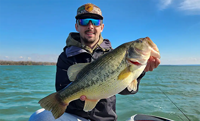 "It’s no secret in the world of bass fishing that big fish eat big baits. It’s also true that big fish eat smaller fish. Have you ever caught a nice bass on a crappie jig? That’s why there are so many size, shape and color patterns across thousands of different baits on the market today. Finding out what the bass are eating and matching the hatch is one of the most crucial elements in catching more and bigger bass.
"It’s no secret in the world of bass fishing that big fish eat big baits. It’s also true that big fish eat smaller fish. Have you ever caught a nice bass on a crappie jig? That’s why there are so many size, shape and color patterns across thousands of different baits on the market today. Finding out what the bass are eating and matching the hatch is one of the most crucial elements in catching more and bigger bass.
When you throw in weather, water level fluctuations and fishing pressure, it can turn those biting fish into temperamental lockjaws. They just might not want to eat anything! When this occurs, most anglers think to throw the kitchen sink at them, pulling out every lure in their tackle box. And sometimes it just doesn’t do the trick. Intuitive anglers think outside the box and ..." Read Article to Learn More >> Go Big or Small When Fish Have Lockjaw
 July 22, 2025 "Suffering? For Your Sport"
July 22, 2025 "Suffering? For Your Sport"
![]() Q) Todd Johanson wrote, “Jeff, after reading your article about checking out new lakes with your wife, I must ask why you don’t just pick a half dozen good lakes and stick with them throughout the season? If you ask me, it sounds like a lot of trouble for nothing. In my area, there are a few lakes that I pretty much always know where to catch fish and I just hit them up when I need a fishing fix. It looks like you guys do a lot of suffering for your sport.
Q) Todd Johanson wrote, “Jeff, after reading your article about checking out new lakes with your wife, I must ask why you don’t just pick a half dozen good lakes and stick with them throughout the season? If you ask me, it sounds like a lot of trouble for nothing. In my area, there are a few lakes that I pretty much always know where to catch fish and I just hit them up when I need a fishing fix. It looks like you guys do a lot of suffering for your sport.
A) Thanks for the note Todd, your comments are especially timely today because I happen to have a real-life example for you this morning.
First off, let me say that I agree with you, there are a handful of lakes in my region too where fishing is, or usually is, reliable. So, if I and the Hippie Chick just needed an occasional fishing date together, we’d typically be good to go. The elements that make up a good, guided fishing charter are different though, and there are several additional factors to consider. Here’s a short list of the reasons why having a diverse repertoire of lakes to fish is so important to me.
First on my list is the geographic location where my customers have their lodging. For example, let’s say that someone is staying near Bemidji, it could be a hardship for me to ask them to drive over to Grand Rapids. Additionally, there are times when folks are staying on a given lake, and they prefer to fish on, or near that lake. It’s good for me to have a working knowledge of several geographic regions, and the lakes within a reasonable distance to them.
Second, on my list are the species of fish that are available in each lake. Most often, walleyes are a primary target for my customers, but not always. Sometimes other species are just important, maybe more important to them. Crappies, Smallmouth Bass, Northern Pike and panfish are all popular target species too, and I like to know a lake or two in every region where fish of quality size are available.
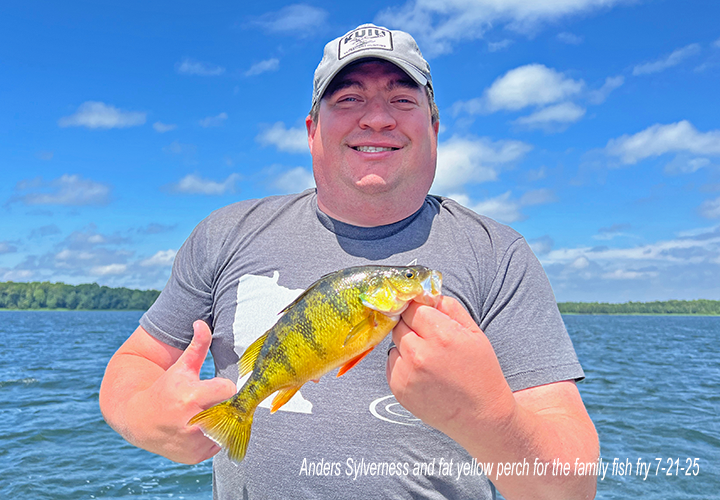 The third item on my list is a Big One and it is my own impact on the lakes I fish. In my experience, there is no lake with a large enough population of fish that it can withstand being pressured repeatedly by skilled anglers. Granted, some are more resilient than others, but even the largest and most productive lakes respond negatively to being “over fished”. There are lakes within my service area that I dare not fish more than once or twice in a season. It’s my responsibility, I think, to figure out how often I can visit any one of my favorites.
The third item on my list is a Big One and it is my own impact on the lakes I fish. In my experience, there is no lake with a large enough population of fish that it can withstand being pressured repeatedly by skilled anglers. Granted, some are more resilient than others, but even the largest and most productive lakes respond negatively to being “over fished”. There are lakes within my service area that I dare not fish more than once or twice in a season. It’s my responsibility, I think, to figure out how often I can visit any one of my favorites.
Along those lines, residents and local anglers can be easily annoyed by seeing the same boats fishing on “their” lakes repeatedly. Folks are generally friendly and welcoming but try fishing on the same lake for several days in a row and watch their attitudes change. A good lesson in my life has been to treat every lake like it’s the one where we have a family cabin. Being sensitive to the image portrayed on the water is always in my mind.
The fourth item on my list is to have a lake or two reserved or saved in my back pocket for an emergency. Take yesterday as an example, fishing on Lake Winnie would have been my ideal game plan, but the strong winds were prohibitive, especially for a half day trip. We wanted to catch walleyes, but knew for sure that the family was also depending on my crew, Alex and Anders to bring home fish for dinner. So, we visited a small, multi-species lake where I can usually get enough fish to “save the day”. The lake didn’t cough up a ton of fish, but there were enough perch, pike and walleyes to gather a family fish fry.
I'd be my own worst enemy if I were to use small lakes like this one too often. Just when I need it most, it might not be available to "save the day when conditions get rough.
Finally, there are days when I simply want to see some fresh scenery. Even after 40 years of guiding in north central Minnesota, the list of lakes I have not fished, is much longer than the list of ones that I have fished. So, it feels good to see new places and even now, there’s a certain thrill that comes when I catch the first fish from a lake that I’ve never seen before. So, yes Todd, you’re right; it is more trouble to find fresh territory, but the rewards outweigh the effort.
I’ve written before that for every 3 lakes I try, one will be a dud, 1 will be so-so, and 1 of them will be a lake I fall in love with. So, I’m willing to forego an expectation of always catching fish in exchange for what I learn during the pursuit of learning new lakes. Hopefully, by the time Susan and I have sorted through "the duds", we will have discovered enough winners to help me provide good experiences for my charter customers. ![]() — Jeff Sundin, The Early Bird Fishing Guide Office Cell Call or Text 218-245-9858 or Email on Facebook on X
— Jeff Sundin, The Early Bird Fishing Guide Office Cell Call or Text 218-245-9858 or Email on Facebook on X
 July 22, 2025 "Water Temperatures — Are the Warmest Days Behind Us?"
July 22, 2025 "Water Temperatures — Are the Warmest Days Behind Us?"
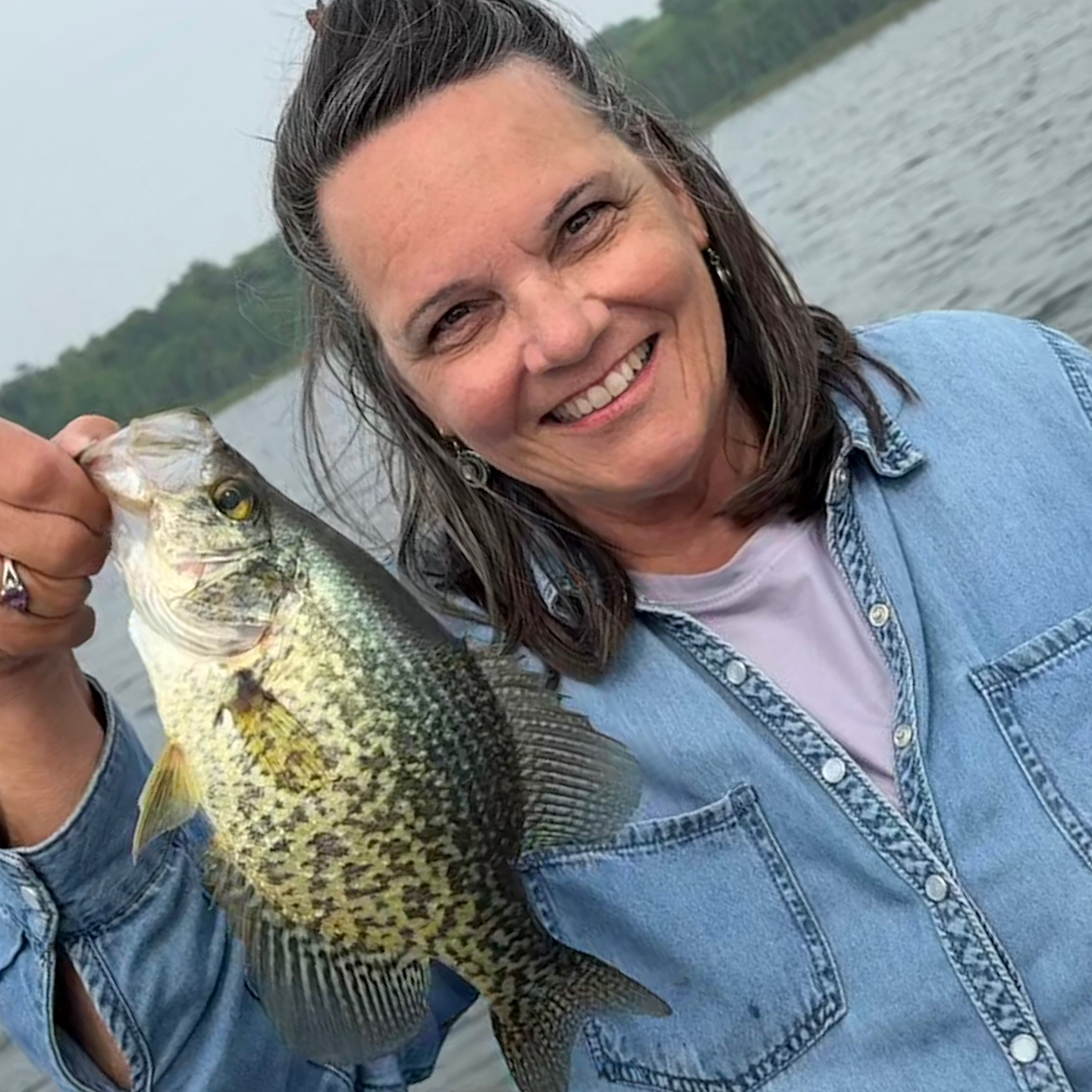 I and the Hippie Chick took off to explore fresh territory on Sunday. Our goal was to find a new (to us) lake where we might find some walleyes, along with crappies as a plan B backup. The first lake, a small, less than 1000-acre lake in the northeast Bemidji area, was nearly ruled out before we arrived at the landing site.
I and the Hippie Chick took off to explore fresh territory on Sunday. Our goal was to find a new (to us) lake where we might find some walleyes, along with crappies as a plan B backup. The first lake, a small, less than 1000-acre lake in the northeast Bemidji area, was nearly ruled out before we arrived at the landing site.
The 5 miles of washboarded gravel road was so nasty that I couldn’t drive faster than about 10 MPH. Turning back, after an hour and a half of driving did't appeal to us. But by the time we arrived at the landing, everything in my boat had been jostled into new positions and I considered myself lucky that nothing was broken. Still, even if we never go back, we’d already made the long drive, and we decided to try the lake anyway. Now I was hoping that our "suffering" would be rewarded by finding some good fishing.
What we found was another great lake for catching skinny northerns. Even the longest one, about 26 inches, was skinny and anemic looking; not the sign of optimism I’d hoped for. Other fish we encountered included small sunfish and perch, along with a single 12-inch-long walleye. Long story short, we didn’t find any reason to spend the rest of our day there. So, we loaded up, did a cleanup, and moved west to try another lake.
At the next stop, a larger, 3000 plus acre lake, we’d encounter more fish but still not “the ones” that we were looking for. The mix included crappies, sunfish, rock bass and small pike and if we’d been fishing for fish to bring home, we would likely have been happy. The problem is that my goal of finding walleye water for an upcoming guide trip was not accomplished. The lake, while not being ruled out, will be on the back burner until a time when the crappies, and or sunfish can be targeted for a day or two.
Because of our limited time, the only presentation we used was trolling spinners. If I’d spotted a school of “walleye looking” fish on my graph, we’d have stopped the boat and geared up to fish them. In the time allotted, that school of fish remained out of my view.
The most important observation from both lakes was the water temperature. At 71 to 72 degrees, they are fully 5 to 6 degrees cooler than they were just a couple of weeks ago. It is highly likely that the warmest water temperatures of the summer have come and gone. I know, there will still be some warm weather, and temps will rebound a little bit, However, I think we’d seen the warmest water that will occur for the 2025 season. I’ll be following the trajectory, but this could well mean that this is, or was, one of the shortest mid-summer, mixed-bag, action fishing seasons that I can recall.
Okay, the walleye fishing might not have been what we'd hoped for, but we did find clues about what might be good crappie fishing at another time. Plus, Susan and I did get to spend a quiet day together and after a hectic week, that was more than enough of a highlight to sastisfy me.
My charter group for today is staying in the north Cass Lake area. So, because I didn’t find a “new” walleye spot, we’ll be meeting up at Lake Winnibigoshish. The weather appears to be offering me a lucky break, and maybe, an easy fishing date. Whatever happens will be the subject of tomorrow’s report. ![]() — Jeff Sundin, The Early Bird Fishing Guide Office Cell Call or Text 218-245-9858 or Email on Facebook on X
— Jeff Sundin, The Early Bird Fishing Guide Office Cell Call or Text 218-245-9858 or Email on Facebook on X
 July 20, 2025 "Working Harder or Working Smarter? Believing the Believe-Able"
July 20, 2025 "Working Harder or Working Smarter? Believing the Believe-Able"
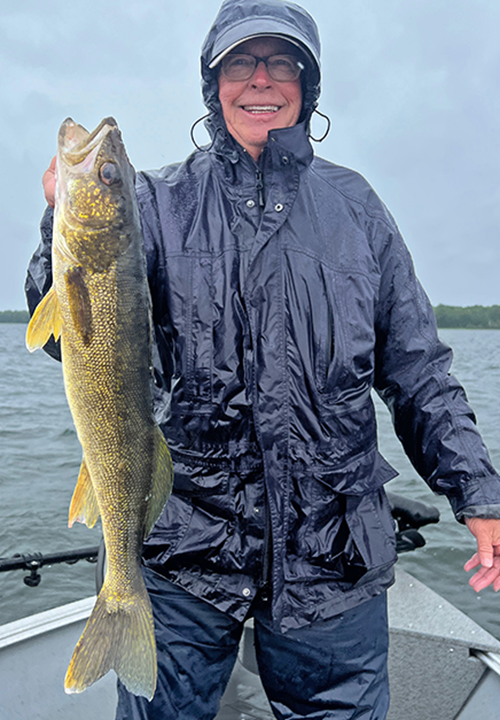 Yesterday, I texted a couple of fish photos from our Thursday-Friday fishing trip to one of my customers. He replied “Thanks for the pictures. We had a great time fishing with you. Yesterday’s experience, fishing in the rain all day long will hold a prominent place in our anthology of fishing stories.” My reply to his text, “Thank you and yes, the weather always seems to be the big picture in the little story.”
Yesterday, I texted a couple of fish photos from our Thursday-Friday fishing trip to one of my customers. He replied “Thanks for the pictures. We had a great time fishing with you. Yesterday’s experience, fishing in the rain all day long will hold a prominent place in our anthology of fishing stories.” My reply to his text, “Thank you and yes, the weather always seems to be the big picture in the little story.”
My comment seemed benign in the moment, but later, when I shared the exchange with my wife, she said, “That is so true”, and when I think about it, it really is true, the weather, when it comes to fishing, IS EVERYTING!
The pictures confirm what my customers said, it did rain all day. Notice that on Friday in the rain, the photos have walleyes in them. Their photo from Thursday, July 17, 2025 while it reveals a warm and sunny day, does not have fish in it, only people; curious huh?
The contrast between those 2 days was about as stark as it gets. On Thursday, fish were buried in the weeds, and we literally had to root them out. So, while we did some, catching them required focus, determination and dare I say, stubbornness. On Friday, the rainy, breezy weather coaxed fish out of the heavy cover/ Now they were riding high above the weed tops and were accessible to our fishing lures and bait. Catching them was much easier and required much less effort.
 I’ve written before, but it bears repeating that I once watched Al Lindner on television on a day that his words changed my life forever. I’ll be paraphrasing, but what he said in that TV show was along these lines. “After a weather change, anglers have to understand that to catch fish, we need to work harder, and smarter, for less.” While not an exact quote, the message’s intent is very close. Lindner did not say that you’ll get skunked if the weather conditions are unfavorable. He did say that if you work harder, and use your brain, you will likely catch at least some, albeit not as many fish.
I’ve written before, but it bears repeating that I once watched Al Lindner on television on a day that his words changed my life forever. I’ll be paraphrasing, but what he said in that TV show was along these lines. “After a weather change, anglers have to understand that to catch fish, we need to work harder, and smarter, for less.” While not an exact quote, the message’s intent is very close. Lindner did not say that you’ll get skunked if the weather conditions are unfavorable. He did say that if you work harder, and use your brain, you will likely catch at least some, albeit not as many fish.
Do you remember my walleye fishing report from June 23, 2025 “Can You Talk Yourself into Winning?” If not, it wouldn’t hurt you to read it. The takeaway from that report was that you can influence yourself by believing that winning, even under unfriendly weather conditions, IS AN OPTION.
Okay, so back to the present day. I mentioned that there were no fish pictures from Thursday, the sunny, calm day. The reason is that while we did get 6 walleyes that day, I caught 5 of them and I consider it rude to show pictures of me catching a fish, when my customers didn’t. The reason you see photos of fish from the Friday trip is that they were not caught by me, but by my charter customers, which is the desired outcome of any fishing trip for me.
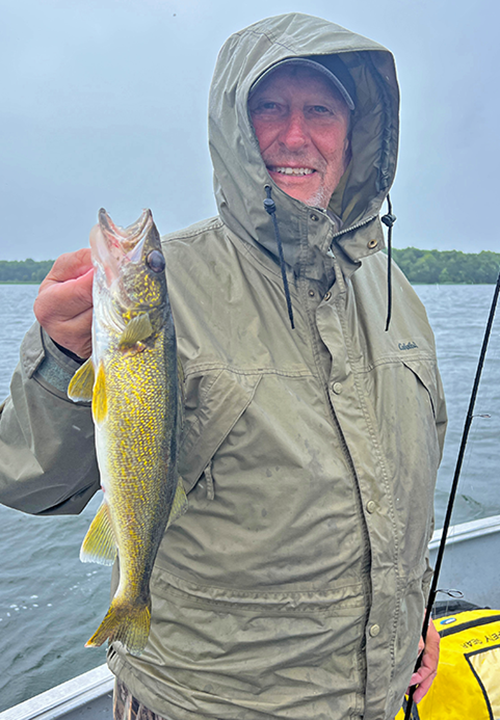 After our fishing trip on Thursday, I cooked a fish dinner for my crew in the back yard of our palatial estate. Because we were at our home, the Hippie Chick was able to join us. So, we had lots of time to chat with my crew about the day’s fishing experience. One topic, always popular at our house, is the power of positive thinking and how it can be harnessed to create an image of a desirable outcome. Some people value the advice more than others, and I believe I saw evidence of that on Friday.
After our fishing trip on Thursday, I cooked a fish dinner for my crew in the back yard of our palatial estate. Because we were at our home, the Hippie Chick was able to join us. So, we had lots of time to chat with my crew about the day’s fishing experience. One topic, always popular at our house, is the power of positive thinking and how it can be harnessed to create an image of a desirable outcome. Some people value the advice more than others, and I believe I saw evidence of that on Friday.
Like I said, on Friday, fishing conditions were favorable, and fish were much easier to catch. Still, even though both men caught some fish, one of them had a bang-up day, while the other still struggled a little bit. At the end of my charter on Friday, while I was cleaning their walleyes, I overheard the one man saying to the other; “You know why you didn’t catch as many fish as me today? Because you didn’t tap into the communication network with the fish. Susan told us all about it, remember?”
Alright, I’m not saying that you don’t still need to know how to catch a fish. But I am saying that if your mind isn’t right, you’re going to miss out on some of your best outcomes. Believing that you can win, and visualizing how that win will come about, will make a difference in your success. I think too that Al Lindner was basically saying the same thing 40 plus years ago. I wonder though, instead of “working harder”, maybe the updated phrase could be “working smarter, and visualizing your own success?”
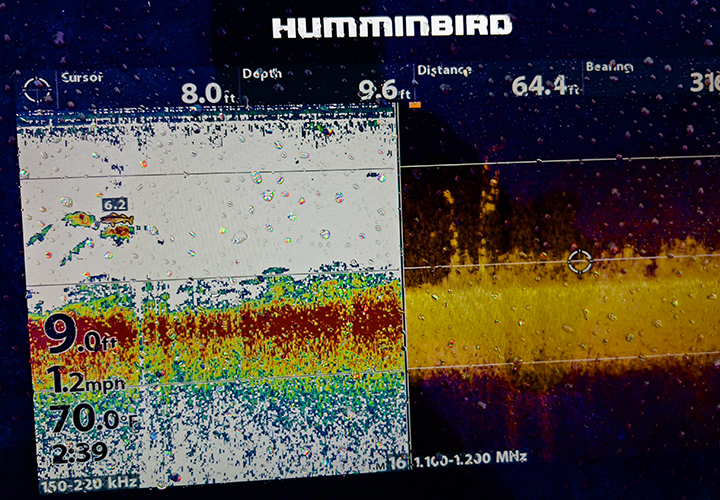 The nuts and bolts about catching our fish on both days are familiar. Trolling spinners tipped with either fatheads or night crawlers was the mainstay presentation.
The nuts and bolts about catching our fish on both days are familiar. Trolling spinners tipped with either fatheads or night crawlers was the mainstay presentation.
On Thursday, the sunny day, walleyes, along with other fish including pike, sunfish, bass and perch, were located at the base of the weedline in water depths of 9 to 11 feet. Using traditional bullet sinkers and fishing over the tops of the weeds caught everything except walleyes. To catch walleyes required rigging heavier, ¾ ounce egg sinkers ahead of our spinners to keep them running deeper, about 1 foot above the bottom over the clean, sandy outside edge of the heavy weed cover.
On Friday, the rainy day, walleyes, along with other fish including pike, sunfish, bass and perch, were located higher, over the weed tops in water depths of 5 to 7 feet. Using traditional bullet sinkers, 1/8 to 3/16 ounces and fishing over the tops of the weeds caught everything, including not only walleyes, but some chubby bonus perch too. To catch walleyes required keeping our lines short, holding our spinners about 20 feet behind the boat. The short lines and lightweight sinkers allowed us to keep them running above the heavy weed cover, and in the strike zone.
Waiting for the weather to turn favorable before going fishing is not an option for me. I have to figure out a way to catch some even when conditions are against me. You may have other options though, like using the crepuscular periods to your advantage. A friend of mine did well fishing on Thursday by starting his charter early in the morning. “The fish bit good during the morning, but the action fizzled out after 11:00 AM”, he advised in a Friday morning recap of his trip. Fishing during the evening twilight helps too, and for some, trolling the flats after dark is working as well. So, if you’re schedule allows, and the weather turns bright, consider those options too.
Today, the Hippie Chick and I are turning a scheduled day off into a research day. We’re going to check out a lake that we’ve never tried before. I may not where to go yet, but you can bet that we’ll be using the power of positive thinking to visualize a happy outcome. I’ll let you know, one way or another, how it goes tomorrow morning. ![]() — Jeff Sundin, The Early Bird Fishing Guide Office Cell Call or Text 218-245-9858 or Email on Facebook on X
— Jeff Sundin, The Early Bird Fishing Guide Office Cell Call or Text 218-245-9858 or Email on Facebook on X
 Wired2Fish July 19, 2025 "Summer Bass Fishing – Beginner to Advanced"
Wired2Fish July 19, 2025 "Summer Bass Fishing – Beginner to Advanced"
 "Travis Tuthill loves his walleye as much as the next Minnesotan, but with a lot of the lakes near his home in the state’s south central region prone to heavy fishing pressure, them ‘eyes aren’t easily fooled. The bite can be tough, but Tuthill’s not singing the blues — he’s catching them.
"Travis Tuthill loves his walleye as much as the next Minnesotan, but with a lot of the lakes near his home in the state’s south central region prone to heavy fishing pressure, them ‘eyes aren’t easily fooled. The bite can be tough, but Tuthill’s not singing the blues — he’s catching them.
Bluegill, that is. The most popular and widely dispersed member of the panfish clan inhabits most of the waterways spanning the northern U.S., so anglers in the know can enjoy a vibrant fishery that’ll put some mighty fine fillets on the table, even when walleye play hard-to-get. Give bluegill fishing a shot.
Where To Look: During the summer months, bluegill value cooling shelter as much as any creature, but they also want plenty of food. Voracious gluttons, these aggressive fish will gobble a variety of finfish and aquatic insect forage. One of the best places to find such food-rich habitat is ..." Read Article and Learn More >> Minnesota Blues: Bluegills in the North Country
 July 18, 2025 "Mille Lacs Lake Walleye Limits Under Review?"
July 18, 2025 "Mille Lacs Lake Walleye Limits Under Review?"
 The announcement of a Mille Lacs Lake Advisory Group meeting on July 23, 2025, comes at a time when Tim Spielman, Outdoor News, published an update about walleye fishing on the big lake. In it, Spielman asserts, “For the second season in a row, the Lake Mille Lacs state-angler walleye kill remained at the end of June far below a quota set during state DNR-tribal co-management negotiations last winter. “
The announcement of a Mille Lacs Lake Advisory Group meeting on July 23, 2025, comes at a time when Tim Spielman, Outdoor News, published an update about walleye fishing on the big lake. In it, Spielman asserts, “For the second season in a row, the Lake Mille Lacs state-angler walleye kill remained at the end of June far below a quota set during state DNR-tribal co-management negotiations last winter. “
Apparently, the MN DNR is considering, or at least open to talking about the potential for raising bag limits for walleye anglers on Mille Lacs. Spielman’s article continues, “Now, with just over 20% of the quota (23,500 pounds of an allowed 113,600 pounds) considered harvested or having succumbed to hooking mortality, DNR officials are considering loosening regulations, likely in mid-August, according to Brian Nerbonne, DNR fisheries central region manager.”
For Mille Lacs Lake Walleye enthusiasts, this could be good news in and of itself. For fisheries biologists and anglers closely watching the debate over statewide walleye limit reductions, it renews concerns about one question. How many fish can anglers be allowed to harvest while still protecting brood stock sufficiently to replenish populations of one of the state’s most valuable natural resources?
To add your 2 cents to the Mille Lacs conversation, contact one of the members of the Mille Lacs Lake Advisory Commitee or attend the meeting, DNR announcement below.
 News Release July 18, 2025 "Mille Lacs Fisheries Advisory Committee meeting is July 23, 2025"
News Release July 18, 2025 "Mille Lacs Fisheries Advisory Committee meeting is July 23, 2025"
"The Mille Lacs Fisheries Advisory Committee (MLFAC) will meet from 6-8 p.m. Wednesday, July 23, at Appeldoorn’s Sunset Bay Resort (45401 Mille Lacs Parkway, Isle, MN 56342) and via online videoconference. The agenda will cover summer creel survey updates, regulations updates, spring northern pike and smallmouth bass updates, Fisheries Technical Committee highlights, and the Mille Lacs Band telemetry research project.
Members of the public may observe MLFAC meetings, but these meetings serve primarily as a way for the committee to hold group discussions. Ten minutes are reserved for public comments and questions. For the upcoming online meeting, members of the public who wish to observe the meeting or speak during the public comment period should contact millelacs.fisheries@state.mn.us by Wednesday, July 23, 2025 at noon. Meeting minutes will be posted after the meeting on the Mille Lacs Lake management page.
Individuals with a disability who need a reasonable accommodation to participate in this event, please contact the Mille Lacs Lake area fisheries office by email at millelacs.fisheries@state.mn.us or by phone at 218-429-3031 or using your preferred Telecommunications Relay Provider.
The committee has been active since October 2015. Its purpose is to advise the Department of Natural Resources on the State of Minnesota’s fisheries management program for Mille Lacs Lake. For more information about DNR’s management of Mille Lacs Lake and how to get involved, visit the Mille Lacs Lake management page."
As always, your comments, opinions and questions are valued. Don't wait for a gold engraved invitation, drop me a line anytime.
 July 17, 2025 "The Fish Do Not Have A Plan"
July 17, 2025 "The Fish Do Not Have A Plan"
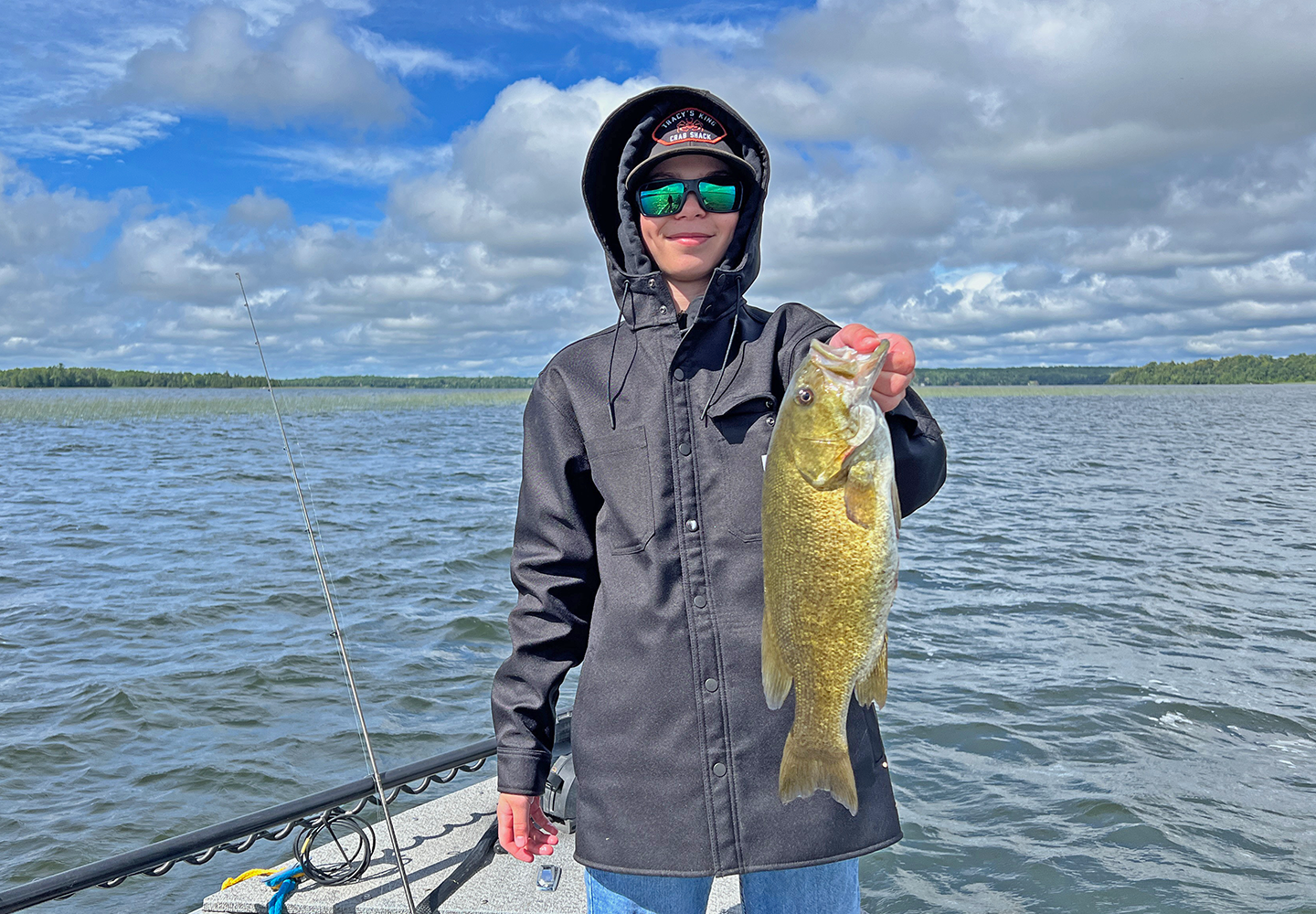 I found myself in an unusual situation on Wednesday; in a way, I was the “cleanup batter”. My charter, father and son, John and Jake Smithburger had already been fishing with another guide for a couple of days. So, they already had most of their legal limits of walleyes, and crappies, plus a smattering of pike, perch and sunfish. They hadn’t caught any smallmouth bass, so, after some deliberation, we decided to try a lake where we could get those and maybe finish off their walleye limits while we were at it.
I found myself in an unusual situation on Wednesday; in a way, I was the “cleanup batter”. My charter, father and son, John and Jake Smithburger had already been fishing with another guide for a couple of days. So, they already had most of their legal limits of walleyes, and crappies, plus a smattering of pike, perch and sunfish. They hadn’t caught any smallmouth bass, so, after some deliberation, we decided to try a lake where we could get those and maybe finish off their walleye limits while we were at it.
The lake, roughly 3000 acres, is moderately clear, and offers a mix of most every one of the common fish species. When we arrived, the surface water temperature was 71 degrees, a 5 degree decline resulting from the arrival of Tuesday’s cold front, The east-northeast wind was chilly, and there were some whitecaps blowing across the lake. The sky was grey, and it looked more like a good duck hunting day, than a smallmouth bass fishing day. Still, that was the work assignment, and I set out to help the crew accomplish their goal.
Presentations for smallmouth that I prefer, like wacky worms and surface baits were off limits because of the wind. So, I chose wiggle worming as the first option and hoped for a favorable response from the fish. Controlled drifting while working the shoreline breaks in 8 to 16 feet of water was my “plan”. Long story short, the fish were fairly responsive and as you can see in the accompanying photos, we did get some nice bass. The problem was that my crew wasn’t necessarily thrilled with the weather adjusted “game plan”.
Effective or not, the finesse presentation wasn’t providing the same thrill as the action packed, mixed bag, spinner fishing they’d been enjoying on previous days. So, after a high-level confab with the fishing committee, I decided to switch game plans and move to a lake where we might duplicate their previous accomplishments.
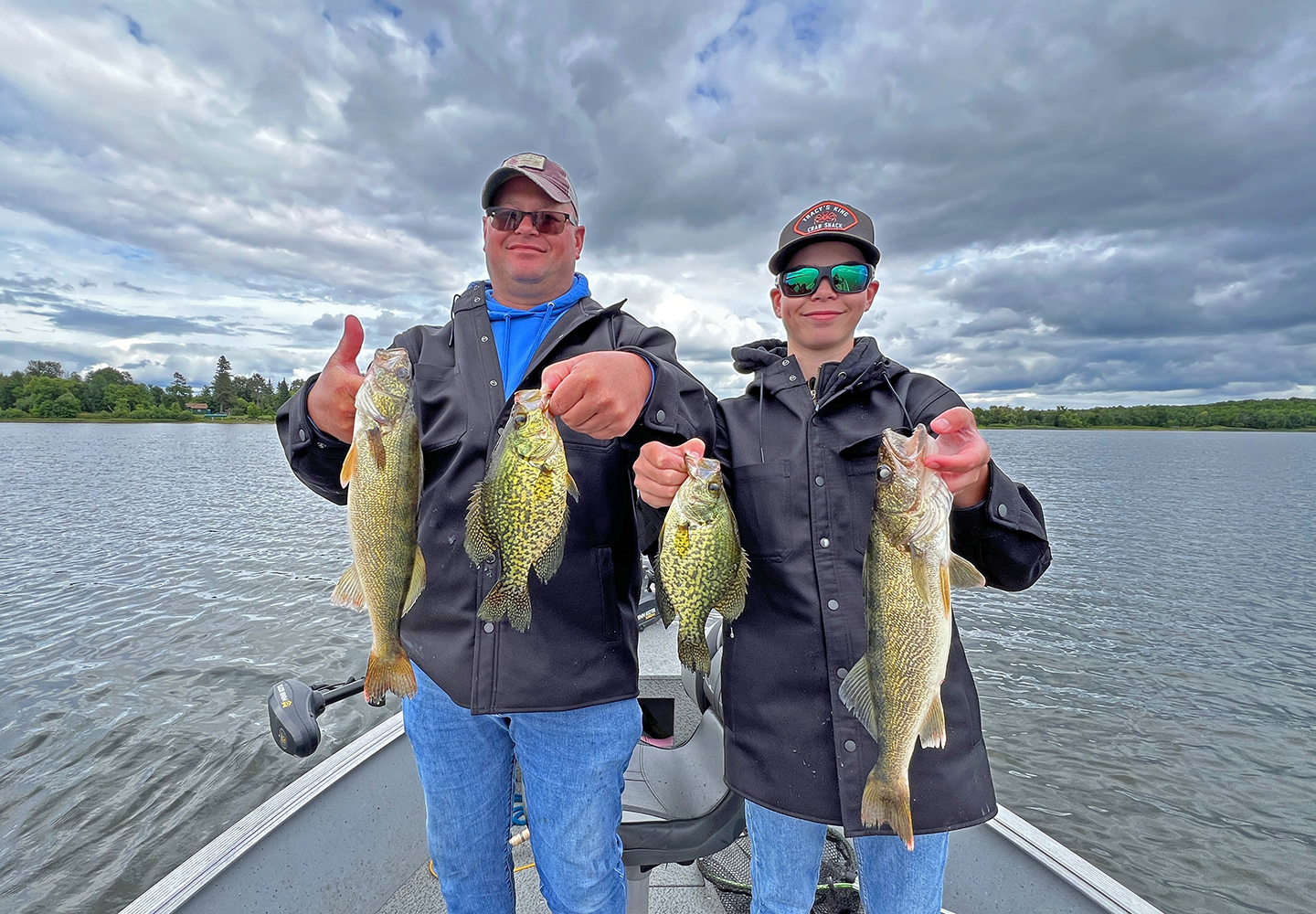 The next lake, one that I’d fished on this past Sunday, was cooler too. Now, ranging between 70 and 71 degrees, the water temperature was 5 or 6 degrees cooler than it was on Sunday. The impact on fishing was obvious to me, but for the crew, maybe not. Northern pike, along with a few walleyes and crappies were semi-cooperative, and while the action was not fast and furious, it was better than we’d seen on our bass fishing expedition.
The next lake, one that I’d fished on this past Sunday, was cooler too. Now, ranging between 70 and 71 degrees, the water temperature was 5 or 6 degrees cooler than it was on Sunday. The impact on fishing was obvious to me, but for the crew, maybe not. Northern pike, along with a few walleyes and crappies were semi-cooperative, and while the action was not fast and furious, it was better than we’d seen on our bass fishing expedition.
You probably know everything I can report about the presentation already. Spinners, tipped with fatheads and trolled along the weed edges worked as expected. The one notable difference from previous trips was that fish moved off of the shallower weed flats. Instead of holding over the weed tops in 6 to 7 feet of water, they re-positioned to sharp breaking weed edges in 9 to 10 feet. Once we modified “the plan” and began focusing on the steeper edges, the action did improve.
Summing it up, the day wasn’t the easiest one I’ve ever had, but it wasn’t bad either. We caught some nice size smallies, topped off the crew’s walleye and crappie limits and even enjoyed passing the inspection of a MN DNR Conservation Officer. All things considered, I guess I can call it a decent inning for the "cleanup batter".
Today, back on the search for walleyes and then, maybe some more above average size pike. I'll let you in on the results tomorrow.![]() — Jeff Sundin, The Early Bird Fishing Guide Office Cell Call or Text 218-245-9858 or Email on Facebook on X
— Jeff Sundin, The Early Bird Fishing Guide Office Cell Call or Text 218-245-9858 or Email on Facebook on X
 July 17, 2025 "News release: Minnesota DNR seeks input on proposed special fishing regulations"
July 17, 2025 "News release: Minnesota DNR seeks input on proposed special fishing regulations"
The Minnesota Department of Natural Resources is asking for input on several special fishing regulation proposals. The DNR is proposing either new regulations or changes to existing experimental and special fishing regulations for the 2026 fishing season that address the following topics:
- Sand Lake walleye (Itasca County)
- Rainy Lake walleye (St. Louis and Koochiching counties)
- Platte Lake sunfish (Crow Wing County)
- Sullivan Lake sunfish (Morrison County)
- Green Prairie Fish Lake sunfish (Morrison County)
- Long (Higgins) Lake sunfish (Todd County)
- Moose Lake sunfish (Todd County)
- Maple Lake sunfish (Todd County)
- Jewett Lake sunfish (Otter Tail County)
- North and South Ten Mile Lakes sunfish (Otter Tail County)
- German Lake sunfish (Otter Tail County)
- Rush Lake sunfish (Otter Tail County)
- Rabideau Lake sunfish (Beltrami County)
The Minnesota DNR is taking input on these proposals via an online survey through Tuesday, Sept. 30. For additional details or to comment directly by email, U.S. mail, or phone about individual proposals, contact the area fisheries office for the proposal you wish to comment on. General input may also be submitted through Tuesday, Sept. 30 to Shannon Fisher at shannon.fisher@state.mn.us or 651-259-5206, or via U.S. mail to Fishing Regulations/Shannon Fisher, Box 20, Minnesota Department of Natural Resources, 500 Lafayette Road, St. Paul, MN 55155.
The Minnesota DNR is also hosting a virtual open house and an in-person open house for Rainy Lake, and an in-person open house in the Twin Cities metro area to cover all proposals.
For those who want to attend one of the open houses, information can be found on the Minnesota DNR website or by calling an area fisheries office. Notification of the proposed changes to fishing regulations has been posted at the accesses at each lake included in the proposal.
 July 16, 2025 "Depending on the Depend-Able"
July 16, 2025 "Depending on the Depend-Able"
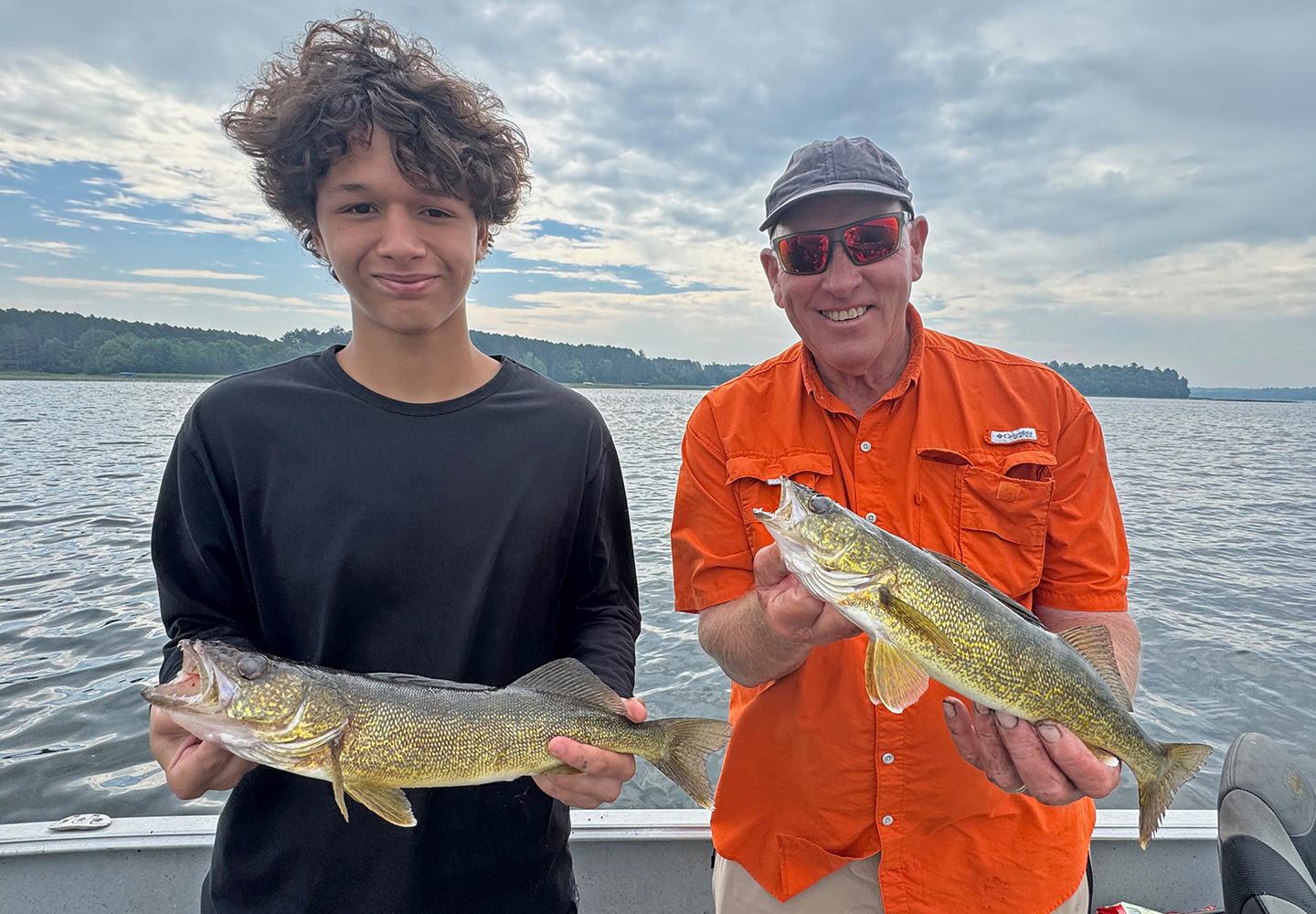 If this week has proven anything to me, it is that my 2 favorite mid-summer walleye presentations will continue being my 2 favorite, mid-summer walleye presentations. They could be or dare I say “should be” yours too. All you need do to be successful using either one is to understand when to choose one, over the other.
If this week has proven anything to me, it is that my 2 favorite mid-summer walleye presentations will continue being my 2 favorite, mid-summer walleye presentations. They could be or dare I say “should be” yours too. All you need do to be successful using either one is to understand when to choose one, over the other.
If this week has proven anything else to me, it is that when it comes to catching northern pike, especially of larger size, location is more important than presentation. Once we know where they are, the “best” presentations are not always the most obvious ones.
Wiggle worming for walleyes, an idea that goes back to me searching for a way to help prevent my kids’ fishing lures from getting stuck in heavy rocks, has been very dependable this week. The jig and night crawler presentation has worked best when walleyes are located on small, well-defined structure. Submerged sandy points, especially when adjacent to weed growth, small rock pikes, and cabbage patches with openings, or gaps between the plants have been reliable.
Wiggle worming is perfect for working the small spots because we can get into the nooks and crannies without getting hung up on structure. Perfect too in the sense that we can move slowly enough to allow sight feeding walleyes the time they need to inhale the bait before small perch, panfish or pike beat them to the lures.
The disadvantage to wiggling worms in the weeds and for some, it’s a bad one, is that small fish will keep you very busy. On Cutfoot Sioux this past Monday, I and the Ted Austin group went through almost 200-night crawlers. Yes, I did say 200 of them. Small perch, sunfish, bass and other species were hitting the night crawlers often. But our reward for putting up with the bycatch, was a nice bag full of keeper size walleyes, and some photos of larger slot fish that we released.
Trolling spinners, my other preferred summertime presentation has worked well this week too. Unlike the ideal wiggle worming spots, the best spinner spots have been long stretches of shoreline weeds where walleyes are spread out horizontally. Trolling spots like these is ideal because we can cover lots of water fast, discovering isolated pods of walleyes as we move.
The disadvantage to trolling spinners, and for some, it’s a bad one, is that small fish will keep you keep you very busy. Sunday, with the Van Thomme family, and again on Tuesday, with the Tom Peterson group, trolling spinners produced a wide variety of fish, many of which were “un-wanted”. But our reward for putting up with the bycatch, was a nice bag full of keeper size walleyes, and some photos of larger slot fish that we released.
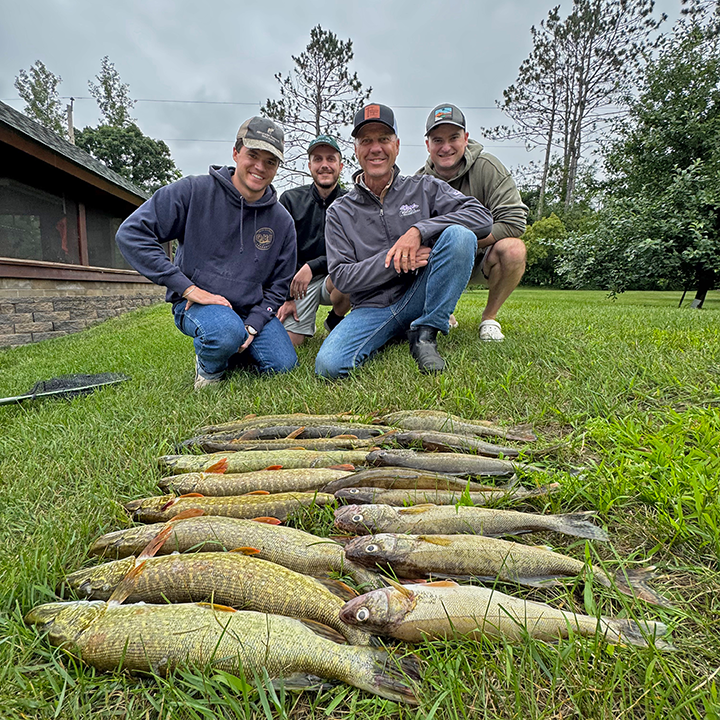 The accompanying photo of the Peterson group shows the makings of a very nice family fish fry. A couple of walleyes apiece, a little bit of coconut pike delight and a batch of blackened pike too. Believe it or not, the primary goal of that trip was to catch northern pike, but not walleyes, and that’s when we learned that there’s more than one way to skin a pike.
The accompanying photo of the Peterson group shows the makings of a very nice family fish fry. A couple of walleyes apiece, a little bit of coconut pike delight and a batch of blackened pike too. Believe it or not, the primary goal of that trip was to catch northern pike, but not walleyes, and that’s when we learned that there’s more than one way to skin a pike.
The Grand Rapids area lake that I selected was clear, and the fish are often less plentiful than many of the lakes with high pike populations. It was chosen for the opportunity to catch larger size pike, rather than catching tons of smaller ones. So, when I met the crew, I was packing a bag filled with large creek chubs. The idea was to split the crew, two of them casting artificial lures while the other two used lindy rigs, and large minnows.
Moving slowly along the outside edges of weeds in 15 to 20 feet of water, northern pike were paying more attention to the minnows than to the swim baits. Soon, the whole crew was using creek chubs and soon, the action became fast and furious. Soon too was the depletion of my bag full of creek chubs. The “all day” supply was almost gone by 1:30 and I had 2 choices, drive back to Grand Rapids to buy more minnows, or try an alternative presentation.
By now, the skies had darkened, and there was a stiff breeze blowing. It made more sense to try “spinning” the weedline than to drive away from the lake, so we stopped at my truck and picked up the fatheads living in my reserve cooler. After re-rigging, I headed for the first spot, a shoreline weed bed in about 12 feet of water. We got in position, threw our spinners in the water and began to troll at about 1.1 MPH. I think it took traveling about 50 yards to get the first fish, a feisty pumpkinseed sunfish, then a rock bass, and then …, a walleye. Hmm, that’s interesting, it looked like we might have a new game plan.
Long story short, the walleyes you see in the photo were all “bycatch” of us trolling for northern pike. While we were trolling, we did still catch a decent number of pike. The walleyes, maybe not the intended species, were nonetheless welcomed into the boat by my crew. If it were not for the ideal conditions, I doubt that we’d caught the walleyes in the shallow water, and that brings me to one of my opening thoughts about understanding when to choose one presentation over the other. Conditions dictate when trolling might work better than slower, live bait approaches like either Lindy Rigging or Wiggle Worming.
If I went back to the same lake and found the sun shining, spinning the weed lines would likely not produce the same results as they did yesterday. So, if I’d been fishing under a sunny sky yesterday, my decision would have been to drive back into town to get more creek chubs.
Use the information for what it’s worth to you, but keep in mind that there are times when going with the flow, and switching up your presentations, might be better than struggling to catch fish using your “favorite” methods at times when conditions do not favor them. ![]() — Jeff Sundin, The Early Bird Fishing Guide Office Cell Call or Text 218-245-9858 or Email on Facebook on X
— Jeff Sundin, The Early Bird Fishing Guide Office Cell Call or Text 218-245-9858 or Email on Facebook on X
 Ely Area, Arrowhead Outdoors Fishing Report July 16, 2025
Ely Area, Arrowhead Outdoors Fishing Report July 16, 2025
 "Walleye - Walleye reports this last week have some anglers finding walleyes sliding back up in water as shallow as 5 to 6 feet. Here, jigs tipped with half a night crawler, leech or paddle tails and pitched to the shorelines has been very effective for anglers.
"Walleye - Walleye reports this last week have some anglers finding walleyes sliding back up in water as shallow as 5 to 6 feet. Here, jigs tipped with half a night crawler, leech or paddle tails and pitched to the shorelines has been very effective for anglers.
Clearly not all walleyes are doing the same thing, (common for) this time of the year. So, reports continue coming in of anglers finding walleyes with spinner rigs tipped with crawlers or leeches and worked off the edge of sunken islands, transiti
on areas, points and weedlines in that 10 to 15 foot of water range. There have been a few reports of trolling crankbaits working but that remains on the slow side yet. Perch, firetiger and gold color baits have been the way to go.
Smallmouth Bass continue to be the safe bet for many anglers as they continue to be aggressive after all these fronts keep moving through the area. As usual for this time of the year, top water fishing continues to be very good before 9am, for smallies. Anglers should be looking to current areas, large boulder flats and down trees for the most consistent action. Once the sun gets up anglers should be adjusting their tactics to wacky worms, chatterbaits, square bills, and spinnerbaits to keep catching smallies. Reports of smallie catches out around sunken islands continue to grow. Oftentimes these are some of the biggest smallies in a system.
Panfish - Both crappies and sunnies are being found right in thick weedbeds right now. Jig and twisters have been a safe bet here for both fish, but any kind of live bait definitely is working here too. If weeds are nonexistent on your lake look at downed trees. Not all downed trees are created equal so some will hold fish while others hold nothing at all. White, pinks and blues have been the best colors for panfish.
Stream Trout - Rainbows trout were easy pickings for anglers trolling small trolling spoons and/or small crankbaits over deep water. Good rule of thumb is that the brighter the better. Trout can be anywhere in 5 to 40 feet of water so pay close attention to your depth finder. Anglers fishing from shore reported a little slower fishing than usual. Here nightcrawlers, fished 5 to 10 feet under a bobber, red/gold kastmaster spoon or 2 inch white twisters were getting the job done.
Lake Trout - Lake trout reports were few and far between this last week, but this isn't to say anglers aren't catching nice lake trout. Large trolling spoons fished behind downriggers in 30 to 50 feet of water were very effective. Anglers fishing from canoes mainly have been aggressively vertically jigging with heavy 5 to 6 inch tubes, while drifting over deep water.
Pike - Small pike continue to be a common catch for many anglers right now. Buzzbaits or large topwater baits fished early in the morning have been very exciting for early morning anglers. Like with the smallmouth, by 9 AM this bite cools off and if you want to keep catching pike, you go subsurface with large spoons, spinnerbaits and large minnow baits. Weedlines, mouths of shallow bays and areas where water comes into the lake, have been the best areas to fish." — Arrowhead Outdoors, 218-365-5358
 Lake of the Woods, LOW Tourism July 15, 2025
Lake of the Woods, LOW Tourism July 15, 2025
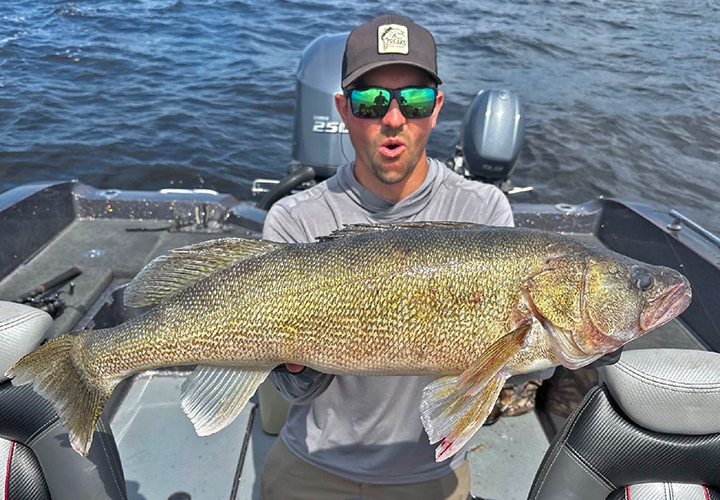 "It’s mid-July, and the fishing action on Lake of the Woods is nothing short of spectacular. From the Rainy River into Big Traverse Bay up to the Northwest Angle, anglers are making memories every day. If you need proof of just how incredible this fishery is, look no further than this photo provided by Fish Donkey, from the Minnesota Tournament Trail (MTT) walleye tournament this past week.
"It’s mid-July, and the fishing action on Lake of the Woods is nothing short of spectacular. From the Rainy River into Big Traverse Bay up to the Northwest Angle, anglers are making memories every day. If you need proof of just how incredible this fishery is, look no further than this photo provided by Fish Donkey, from the Minnesota Tournament Trail (MTT) walleye tournament this past week.
Lake of the Woods recently hosted two back-to-back, one-day catch and release tournaments on July 10, 11, 2025. The MTT uses Fish Donkey, a fishing tournament hosting platform that features Catch Photo Video Release technology. This means fish are quickly measured, photographed, and released back into the lake to fight another day.
The stats from these tournaments are simply jaw-dropping. There were 45 teams competing, and collectively, measured approximately 450 fish each day! On day one alone, there were 9 walleyes over 30 inches recorded and day two topped that with an incredible 16 walleyes over 30 inches.
It’s yet another testament to why Lake of the Woods is proudly known as the Walleye Capital of the World.
Fishing remains excellent along the south end of Lake of the Woods. Interestingly, the jig bite is still going strong, even though by this time of year most anglers typically switch over to pulling spinners with crawlers or trolling crankbaits. This season, all three techniques are producing fish.
- Jigging: The classic jig and frozen emerald shiner combo continues to catch nice walleyes. Hot jig colors have been orange, yellow, gold, gold/chartreuse, and orange/yellow.
- Spinners: Pulling spinners with crawlers is really picking up steam. Gold paired with red, pink, or orange on the blades is a solid bet right now. Trolling around 1.0 to 1.25 mph is a good starting point.
- Crankbaits: Trolling crankbaits is also delivering nice catches. In the stained waters of LOW, colors like gold, firetiger, pink UV firetiger, chartreuse, and chrome/blue are hard to beat.
Walleyes are taking advantage of various forage opportunities, hence, can be found in many areas and depths. The go to depths are 25 to 35 feet of water.
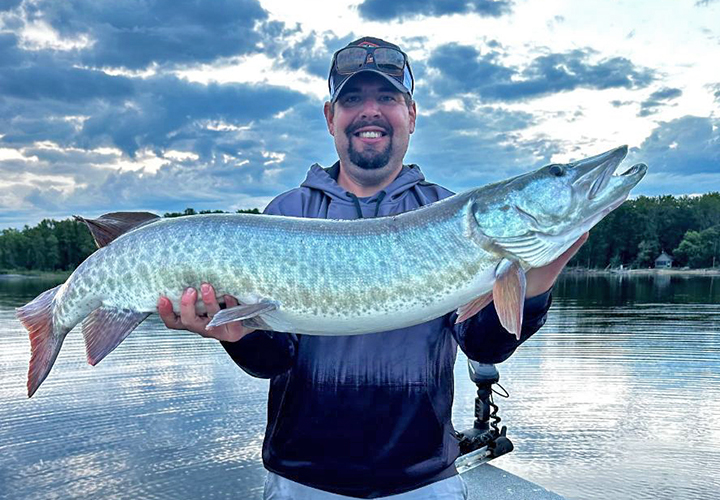 The Rainy River continues to be a relaxing and productive option for anglers. Right now, the sturgeon keep season is open, and some anglers are enjoying the beautiful summer days soaking crawlers for these prehistoric giants. Of course, walleyes and saugers are still in the river too, often hanging out in deeper holes or near current breaks. Plus, don’t forget about the strong population of smallmouth bass and pike in the river — they’re often overlooked but provide some awesome rod-bending action.
The Rainy River continues to be a relaxing and productive option for anglers. Right now, the sturgeon keep season is open, and some anglers are enjoying the beautiful summer days soaking crawlers for these prehistoric giants. Of course, walleyes and saugers are still in the river too, often hanging out in deeper holes or near current breaks. Plus, don’t forget about the strong population of smallmouth bass and pike in the river — they’re often overlooked but provide some awesome rod-bending action.
Up at the Northwest Angle, fishing remains strong with its variety of structure, scenery and wildlife amongst the 14,552 islands in this part of the lake.
- Walleyes: Many anglers are still jigging with minnows or plastics along the edges of structure, in neck-down areas with some current, and off rocky points. Sunken islands surrounded by open mud are also holding good numbers of walleyes. Drifting or trolling these areas with a bottom bouncer and spinner tipped with a crawler or imitation crawler has been super effective.
- Muskies: The muskie bite is picking up as the water warms. Good numbers of fish are being reported, with many caught right at the boat on the figure 8. Gold and bronze blades have been hot colors for those throwing big bucktails.
Multispecies action is common with pike, smallmouth bass and jumbo perch in the mix and shows why Lake of the Woods Shines All Summer. When other walleye lakes across the Midwest start to slow down this time of year because of heavy weed growth, too many young-of-the-year perch or bluegills competing for attention, and boat traffic, Lake of the Woods just keeps pumping out fish. It’s no wonder anglers travel from all over the country to experience this world-class fishery. Whether you’re after eater-sized walleyes for a fish fry or a trophy to photograph and release, Lake of the Woods has it all." — Lake of the Woods Tourism, (800) 382-FISH
 Wired2Fish July 15, 2025 "Summer Bass Fishing – Beginner to Advanced"
Wired2Fish July 15, 2025 "Summer Bass Fishing – Beginner to Advanced"
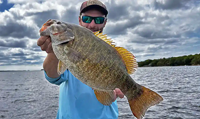 "As the days grow longer, temperatures get hotter, and kids start getting out of school, you know one thing is coming: Summer is officially here! This is the time that many bass anglers across the country have been waiting for. The weeds are up, and the fish have moved into their summer patterns. Deeper water is back in play, and you can catch them almost any way you want to. This is the beauty of summertime bass fishing.
"As the days grow longer, temperatures get hotter, and kids start getting out of school, you know one thing is coming: Summer is officially here! This is the time that many bass anglers across the country have been waiting for. The weeds are up, and the fish have moved into their summer patterns. Deeper water is back in play, and you can catch them almost any way you want to. This is the beauty of summertime bass fishing.
Understanding Summertime Bass Behavior: Unlike the springtime when bass are super shallow, preparing to or are actively spawning, summertime bass act completely different. Once water temps hit that 65- to 70-degree mark, both largemouth and smallmouth bass start changing their habits. While they were probing the shallows all spring, bass behavior shifts, in pursuit of food, shelter, and comfort. First, they need to replace all the nutrients lost from spawning. Then, they look for cover that will ..." Learn More >> Summer Bass Fishing – Beginner to Advanced
 Cutfoot Sioux, Lake Winnie Memorial Day Fishing Report July 14, 2025
Cutfoot Sioux, Lake Winnie Memorial Day Fishing Report July 14, 2025
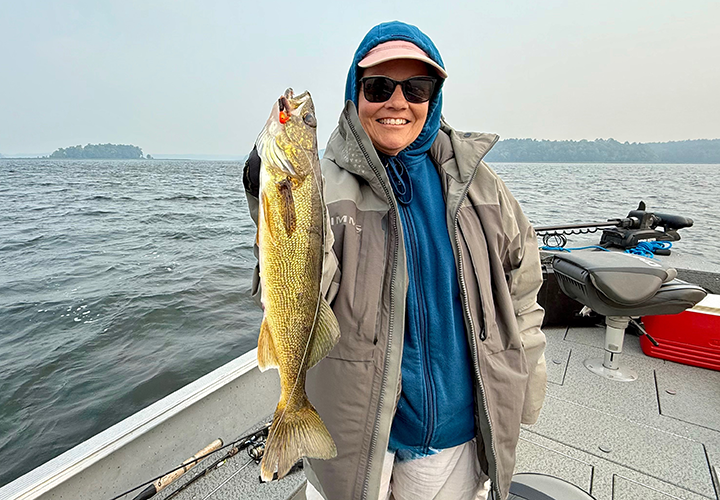 "Surface temperatures have been on the rise this week and were hovering around 75 degrees on Saturday morning. Caused both by warm and sunny temperatures, and an increased water flow because of the recent rainfall, the added warmth has brought on some additional algae blooms. The Secchi disk reading in Cutfoot Sioux was 10 feet deep on Saturday morning. Still clear by historic standards, but far better (for fishing) than the 18-to-20-foot readings we saw early this summer. The added turbidity makes less wary and somewhat easier for anglers to approach and catch.
"Surface temperatures have been on the rise this week and were hovering around 75 degrees on Saturday morning. Caused both by warm and sunny temperatures, and an increased water flow because of the recent rainfall, the added warmth has brought on some additional algae blooms. The Secchi disk reading in Cutfoot Sioux was 10 feet deep on Saturday morning. Still clear by historic standards, but far better (for fishing) than the 18-to-20-foot readings we saw early this summer. The added turbidity makes less wary and somewhat easier for anglers to approach and catch.
Vegetation, especially in Cutfoot Sioux continues to mature. Fish holding plant varieties like cabbage, coontail and flat stemmed pondweed are green, lush and growing deep. Anglers with a long history of fishing Cutfoot Sioux will recall the days when finding a cabbage bed deeper than 8 feet was a chore.
Last week we reported that some of the popular trolling presentations were coming to their peak of effectiveness. Fishing with spinners tipped with live bait produced mixed bags of walleye, pike, perch, rock bass and sunfish. On Saturday, trolling spinners tipped with night crawlers were used to search for fish, but once located, wiggle worming was the preferred presentation and walleyes ..." Read >> Bowen Lodge Lake Winnie Fishing Report July 14, 2025
 July 11, 2025 "Action Slows Down, Quality Picks Up"
July 11, 2025 "Action Slows Down, Quality Picks Up"
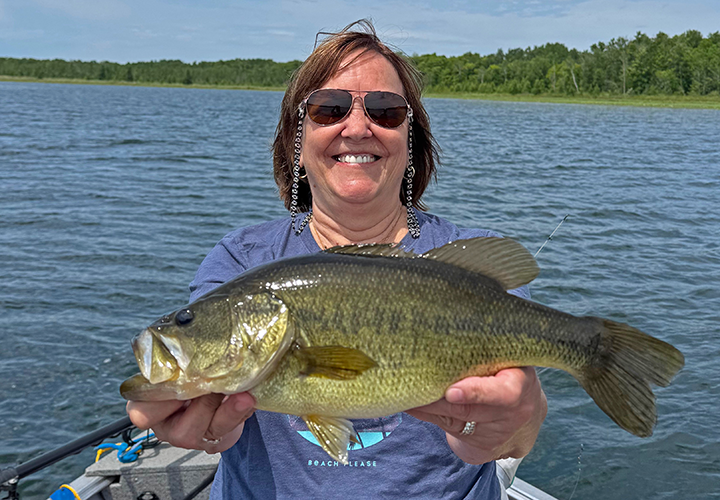 With water temperatures reaching into the 77-to-78-degree range, fish metabolism is running high. So, fish species that become most active in warm water like bass, sunfish and rock bass are feeding fast, and often. I mentioned yesterday that in terms of catching walleyes, fishing action for panfish, perch and bass had been almost too good. “Too good” in the sense that small fish and bass, eager to get a meal, were gulping down our baits before walleyes could get to them.
With water temperatures reaching into the 77-to-78-degree range, fish metabolism is running high. So, fish species that become most active in warm water like bass, sunfish and rock bass are feeding fast, and often. I mentioned yesterday that in terms of catching walleyes, fishing action for panfish, perch and bass had been almost too good. “Too good” in the sense that small fish and bass, eager to get a meal, were gulping down our baits before walleyes could get to them.
That theory makes some sense, but isn’t easy to prove, is it? Thursday, there was some more evidence that helped bolster my belief.
My customers, Paul and Cindy agreed that we should re-visit a small lake that the Hippie Chick and I explored a couple days back. I’d given them advance warning that there would be a lot of “small fish” biting, and that we’d probably get some fish, crappies in particular, but that we’d have to do some sorting to gather “keepers” for the trip home. So, when we arrived at the lake, our expectations were not set too high, but we were hopeful that we’d get enough quality fish to make a day of it.
Before we even met at the hotel, a line of thunderstorms had blown through the Grand Rapids area. The series of early morning storms were not severe, and the post-storm conditions remained warm, calm and cloudy. So, the impact on fishing wasn’t dramatic, but the disruption did reduce the level of action just a little bit. As it happened, the reduction in levels of panfish activity actually worked in our favor. The ratio of larger crappies, largemouth and smallmouth bass improved. Small crappies and sunfish, while still present, were fewer and further between than they had been previously.
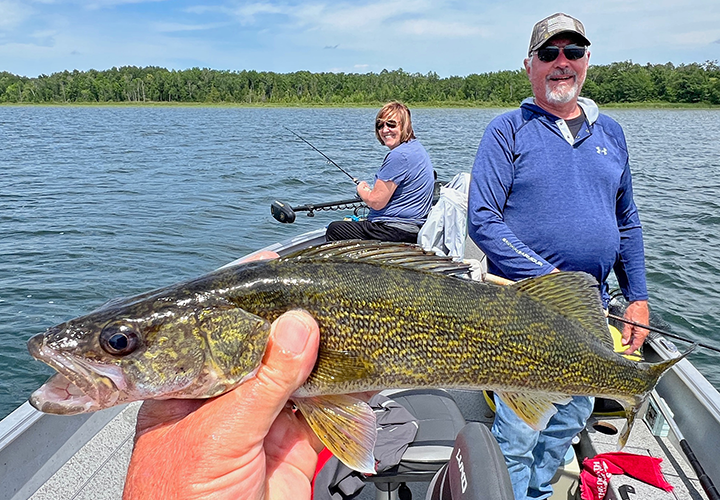 Walleyes, the primary reason for our initial exploration of the lake, never showed up at all on Tuesday. Yesterday though, we caught 7 or 8 of them and harvested 4 “keepers” and they were located along the very same weed edges as the rest of the fish were. The weeds, on this lake, consisted of some cabbage, clasping leaf pondweed, and a lot of flat stemmed pondweed. The vegetation grew to about 12 feet deep, and sometimes tapered off into deeper, 16 to 18 feet water depths.
Walleyes, the primary reason for our initial exploration of the lake, never showed up at all on Tuesday. Yesterday though, we caught 7 or 8 of them and harvested 4 “keepers” and they were located along the very same weed edges as the rest of the fish were. The weeds, on this lake, consisted of some cabbage, clasping leaf pondweed, and a lot of flat stemmed pondweed. The vegetation grew to about 12 feet deep, and sometimes tapered off into deeper, 16 to 18 feet water depths.
To get our spinners running deeper, we added #4 split shot sinkers behind the 3/16-ounce bullet sinkers. My reasoning was that we might find fish in shallower locations, and removing the split shots would be easier than re-tying the rigs entirely. That didn’t happen yesterday, and we stuck with the same sinker set up all day long and they produced good results through the trip.
Because of the discontinuation of Little Joe’s hammered brass blades, my standard spinners these days are the ones I tie myself. I use #3 hammered gold, and #3 hammered copper Indiana blades primarily. Occasionally, I’ll use some colored blades, but I doubt that it’s necessary. On most days, tipping the single 2/0 gold Aberdeen hooks with fatheads works fine. I like to experiment with night crawlers and leeches too, because walleyes sometimes do show a preference. On this lake though, the small sunfish ripped the nightcrawlers to shreds, so I did give up on them and revert to using all fatheads.
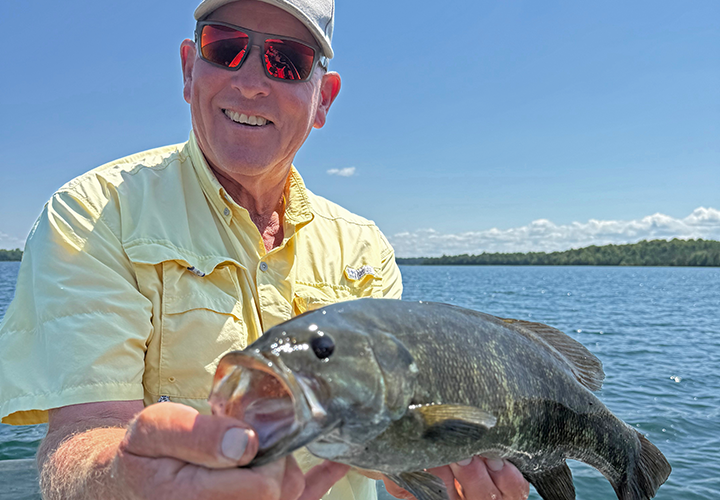 Walleyes, on a lot of “mixed-bag lakes”, can be targeted using my wiggle worming presentation. Sometimes, it’s worth putting up with sunfish striking the night crawlers because they are large enough to provide some additional harvest. On this lake though, the sunfish were not quite large enough to get our attention, so other live bait presentations were abandoned as well.
Walleyes, on a lot of “mixed-bag lakes”, can be targeted using my wiggle worming presentation. Sometimes, it’s worth putting up with sunfish striking the night crawlers because they are large enough to provide some additional harvest. On this lake though, the sunfish were not quite large enough to get our attention, so other live bait presentations were abandoned as well.
For me, fishing during the crepuscular periods isn’t often practical. So, I need to do whatever I can to catch walleyes during the daytime. For you though, catching walleyes on lakes that have a lot of panfish might be better if you focus on the early morning and late evening periods. I got the idea yesterday that walleyes would become more aggressive later in the evening, or on darker, windier days. So, if you’re not into the mixed bag action bite, maybe skipping the middle of the day, and fishing in the evening would be a better option for you.
Okay. So, yesterday’s fishing trip worked out alright, we caught and released a bunch of fish. And the livewell looked good too, we harvested 15 crappies along with the 4 walleyes I mentioned. I think we all went home from the little lake happy. But most likely, this will be the only success story of the season from this small, 400-acre lake. For me, 1 or 2 trips per summer is the most attention most small lakes like these can withstand.
Beginning this Sunday, my work schedule intensifies again, and I’ll need as many ideas as I can muster. So, today, I and the Hippie Chick are planning another exploration to find some more fresh territory. We’ll let you know how the trip turns out. ![]() — Jeff Sundin, The Early Bird Fishing Guide Office Cell Call or Text 218-245-9858 or Email on Facebook on X
— Jeff Sundin, The Early Bird Fishing Guide Office Cell Call or Text 218-245-9858 or Email on Facebook on X
 Wired2Fish July 11, 2025 "Fluke and Topwater Smallmouth Smackdown"
Wired2Fish July 11, 2025 "Fluke and Topwater Smallmouth Smackdown"
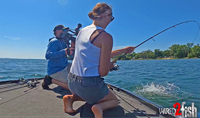 "Join Wired2fish’s Kyle Peterson and his wife Britta on a perfect summer day as they explore Lake Mille Lacs, targeting aggressive smallmouth bass using flukes and topwater poppers. With water temperatures hovering around 70 degrees, conditions are prime for quick action and explosive surface strikes.
"Join Wired2fish’s Kyle Peterson and his wife Britta on a perfect summer day as they explore Lake Mille Lacs, targeting aggressive smallmouth bass using flukes and topwater poppers. With water temperatures hovering around 70 degrees, conditions are prime for quick action and explosive surface strikes.
Scouting Structure for Smallmouth Bass: Rather than fishing heavily pressured areas, the Petersons focus on subtle contour changes and overlooked rock transitions in sandy flats. Using side imaging, Kyle marks isolated boulders and hidden structure that often hold unpressured bass. These less obvious spots offer a better chance to connect with quality smallmouth bass.
Flukes for Clear Water Success: Fluke-style soft plastics are the pick to kick things off. These baits mimic fleeing baitfish, triggering aggressive strikes even in ..." View Video to Learn More >> Fluke and Topwater Smallmouth Smackdown
 July 10, 2025 "Searching the Search-Able"
July 10, 2025 "Searching the Search-Able"
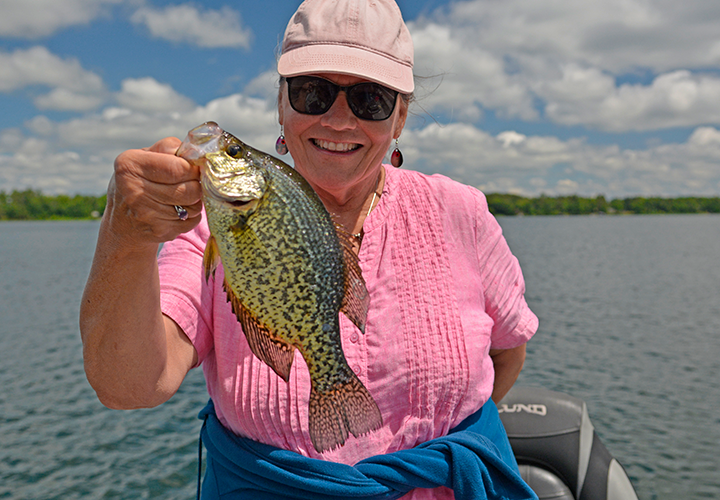 I apologize for the brevity of my report this morning. I woke up to some computer issues and correcting them took up most of the time that I would typically spend writing. But, with the help of my lovely assistant, pictured here, I think you’ll get the idea about what I’ve been up to the past couple of days. Searching for “fresh territory”, I and the Hippie Chick have visited a couple of lakes that we’ve never fished before, and a couple of them that we haven’t visited for a few years.
I apologize for the brevity of my report this morning. I woke up to some computer issues and correcting them took up most of the time that I would typically spend writing. But, with the help of my lovely assistant, pictured here, I think you’ll get the idea about what I’ve been up to the past couple of days. Searching for “fresh territory”, I and the Hippie Chick have visited a couple of lakes that we’ve never fished before, and a couple of them that we haven’t visited for a few years.
The quick update is that water is warm, ranging between 75 and 77 degrees and small fish, sunnies, perch, rock bass and crappies are very active in and around the weeds. Small fish are so active in some lakes that catching preferred species like smallmouth, walleye and large northern pike has become troublesome. Trolling presentations like spinners and minnows will keep you in the action, but expect to consume a lot of bait, and expect to do a lot of “sorting”.
Tomorrow, I’ll elaborate on a couple of ideas about how to single out walleyes, if that’s what you’re into. And I’ll bring you up to speed about where, and how we figured out catching crappies like the one you see presented here by the Hippie Chick.
Before I go this morning, I want to give you an update on the walleye possession limit story. Some folks believed, or maybe hoped that Lake Winnibigoshish, because of it’s present “Special Regulations” status, may be spared the reduction in the possession limit of walleyes. A discussion about that triggered me to wonder what would happen on Lake of the Woods as well. So, I reached out to Minnesota DNR Fisheries staff for an update.
Yesterday, July 9, 2025, I did receive confirmation from Shannon Fisher, MN DNR Populations and Regulations Manager who said, “All border waters (such as Lake of the Woods) follow their own border waters regulations. Therefore, I change in the inland walleye daily and possession limit would not impact any of the border waters. As for all other inland waters, the bag limit change would go into effect UNLESS there is a special regulation already in place. In the case of Winnie, I did not see any special regulations that pertain to bag limits. Therefore, the daily and possession limit would go to 4, but the length limits would stay in place because those are a special regulation.”
That’s where I have to leave the report this morning, but I’ll expand on these and more topics tomorrow morning. ![]() — Jeff Sundin, The Early Bird Fishing Guide Office Cell Call or Text 218-245-9858 or Email on Facebook on X
— Jeff Sundin, The Early Bird Fishing Guide Office Cell Call or Text 218-245-9858 or Email on Facebook on X
 Ely Area, Arrowhead Outdoors Fishing Report July 9, 2025
Ely Area, Arrowhead Outdoors Fishing Report July 9, 2025
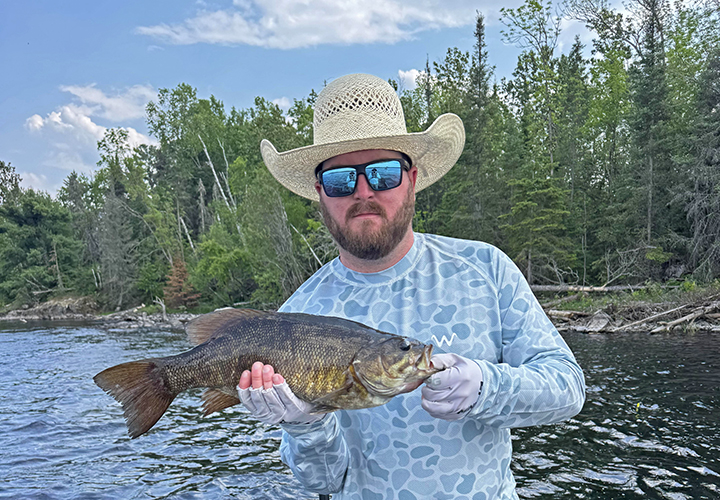 "Smallmouth - Early morning topwater bite remains strong on many of the area's best smallmouth lakes. Anglers have been working shorelines with downed trees and large boulders for the best bite. Once the sun gets up anglers switch to subsurface bait like square bills, chatterbaits, wacky worms and Ned rigs to keep catching smallies. Walleye anglers have reported that smallies have begun moving out to sunken islands now. Majority of smallies are being caught in 10 feet of water and shallower.
"Smallmouth - Early morning topwater bite remains strong on many of the area's best smallmouth lakes. Anglers have been working shorelines with downed trees and large boulders for the best bite. Once the sun gets up anglers switch to subsurface bait like square bills, chatterbaits, wacky worms and Ned rigs to keep catching smallies. Walleye anglers have reported that smallies have begun moving out to sunken islands now. Majority of smallies are being caught in 10 feet of water and shallower.
Walleye - Walleye have been settling into their classic summer patterns like weedlines, sunken islands, windy shorelines and edge of points. Crawlers have been hot, hot, hot lately with many anglers reporting the best bite happening on crawlers. Spinner rigs pulled with bottom bouncers or jig and half a crawler have been getting the job done. Best depth has been 10 to 15 feet of water with firetiger, gold and pink continuing to be the must have colors.
Panfish - Crappies continue to be found in shallow weed beds. Isolated lily pads have been holding crappies as well as coontail clumps and downed trees. 2 inch twisters and other soft plastics have been getting the job done for anglers. Sunfish bite remains strong too for many anglers. Sunfish are being found shallow in wild rice beds and weedbeds. Small leeches, green crawlers, angleworms and wax worms, all fished under a bobber, have been very effective on the sunfish.
Stream Trout - Stream trout anglers seemed to have taken the week off as stream trout reports cooled off. Still, anglers that went out looking for rainbows reported good fishing for them. Many anglers reported finding rainbows on the bottom, with a night crawler floated off the bottom with a marshmallow or a shot of air. Trolling cowbells, with small minnow baits or small trolling spoons has also been very effective.
Lake Trout - Trolling season has started for lake trout anglers in the Ely area. Majority of lake trout anglers are setting down riggers 30 to 50 feet down and trolling large trolling spoons over deep water. Anglers fishing in the BWCA are drifting over deep water while trolling with keel sinkers and trolling spoons, in 30 nto 80 feet of water.
Pike - Large pike remain elusive for anglers this last week as large pike out over deep water chasing ciscos. Smaller pike remain active in shallow bays, weedlines and river mouths. Large spoons, spinnerbaits and large minnow baits trolled or casted around these areas have been very productive." — Arrowhead Outdoors, 218-365-5358
 Reader Comments July 9, 2025 "Honoring the Honor-Able"
Reader Comments July 9, 2025 "Honoring the Honor-Able"
 "Jeff, I was very interested in reading your recent article. As a very lucky person to have a cabin on Cutfoot Sioux Lake, I get to see a lot of anglers exhibit all sorts of behavior. Both by “locals” and “resort guests and outstate guests”.
"Jeff, I was very interested in reading your recent article. As a very lucky person to have a cabin on Cutfoot Sioux Lake, I get to see a lot of anglers exhibit all sorts of behavior. Both by “locals” and “resort guests and outstate guests”.
I can’t say that I have a great sense of how the new (walleye limit reduction) regulations will impact the fish population. The bad actors, those who bring in fish over-limits will not be affected. I believe the only road for improvement comes from within the fishing community. Continuing to stress the “common good and stewardship” of our beloved sport falls to each and every one of us to kindly state the case for conservation and stewardship that is everyone’s responsibility.
What I do feel strongly about is welcoming our outstate guests who vacation in Minnesota. I would love to see the DNR create the capability of someone buying an outstate license to designate a “window “when buying their license when they would be able to keep 6, 8 or more walleyes.
Being able to enter a two-week window of dates on their license at their point of purchase seems to be a great way to demonstrate our appreciation of the tourist dollars they bring to our economy. I believe the technology is there and is in the hands of the DNR and conservation officers in the field.
From the MN DNR Survey: Regarding the 4 daily 6 in possession provision, I would be in favor of that for Minnesota residents. Thank you for your important message to us all. Bob Cass"
 Thank you for the comments, Bob. I hope I didn’t misunderstand the meaning of your term, “bad actors”. I assume that your reference was to my recent article about the MN DNR announcement of the walleye limit reduction proposal when I said, “Thousands of anglers simply disregard possession limit rules every season. They repeatedly catch fish and take some of them home every time they go fishing and wind up over their limit. They believe that if they stay within the so-called “legal daily bag limit” that they’re good to go.”
Thank you for the comments, Bob. I hope I didn’t misunderstand the meaning of your term, “bad actors”. I assume that your reference was to my recent article about the MN DNR announcement of the walleye limit reduction proposal when I said, “Thousands of anglers simply disregard possession limit rules every season. They repeatedly catch fish and take some of them home every time they go fishing and wind up over their limit. They believe that if they stay within the so-called “legal daily bag limit” that they’re good to go.”
To be clear, not everyone who “stockpiles” walleyes in their freezers are intentionally breaking the law. Many simply don’t realize that the term possession limit is to be taken literally and means that when you have your "limit", you are not allowed to harvest any more. They innocently bring fish home and save them for a rainy day, never thinking for a second that they’ve done anything wrong. Admittedly, there are some anglers who knowingly disregard that rule, and have little fear that anyone will ever catch them.
Either way, my point wasn’t necessarily to identify anyone in particular as a “bad actor”. Rather, I hoped to call attention to the fact that tourists, whether traveling in the state, or from another state, do not enjoy that option. They have no choice but to travel with the fish they possess and must remain within their legal possession limit or suffer the consequences.
You’re right, folks spend a lot of money to visit Minnesota and that money goes a long way to support small town economies everywhere in Minnesota. I agree with you, if tourists who travel some distance to stay at a resort, family cabin, motel or campground are already happy with the current regulation that offers “the potential” to bring home 6 walleyes, then we should bend over backwards to help make that happen.
I agree too that using positive peer pressure is the best way to influence folks not to over-harvest our shared resources. There already aren't enough conservation officers to go around. I can't imagine any way that we could hope to "regulate" the number of fish people have in their freezers. Like you said, it falls to us to set good examples, and do our best to encourage our fellow anglers to follow suit.
Sometimes the topic of limits, and how they are enforced, comes up in my boat. What I tell my customers is that mostly we use "The Honor System" to ensure folks don't harvest too many fish. Then I add, when it comes to "Honor", you either have it, or you don't; that usually gets the point across. ![]() — Jeff Sundin, The Early Bird Fishing Guide Office Cell Call or Text 218-245-9858
— Jeff Sundin, The Early Bird Fishing Guide Office Cell Call or Text 218-245-9858
 Lake of the Woods, LOW Tourism July 9, 2025
Lake of the Woods, LOW Tourism July 9, 2025
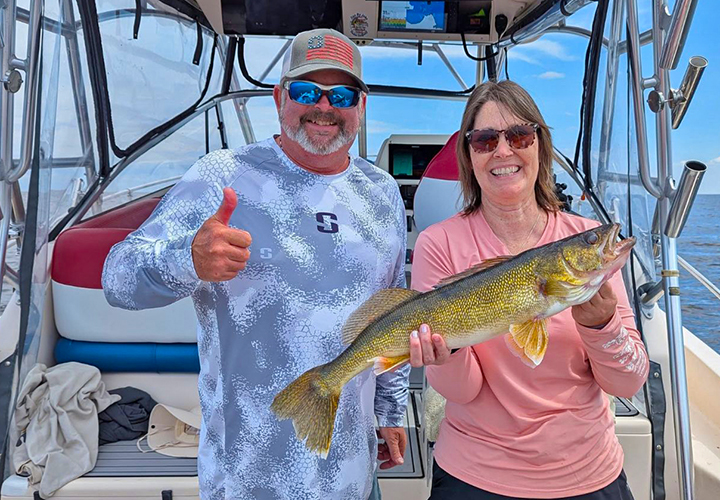 "It’s classic midsummer on Lake of the Woods, and the fishing is living up to its world-class reputation. Right now, anglers are catching walleyes and saugers three main ways: jigging with frozen emerald shiners, pulling spinners with crawlers, and trolling crankbaits. Each of these techniques is putting plenty of fish in the boat.
"It’s classic midsummer on Lake of the Woods, and the fishing is living up to its world-class reputation. Right now, anglers are catching walleyes and saugers three main ways: jigging with frozen emerald shiners, pulling spinners with crawlers, and trolling crankbaits. Each of these techniques is putting plenty of fish in the boat.
On the South Shore, good limits of walleyes and saugers continue to be the story. Fish are being caught in a wide range of depths, from 12 feet all the way out to 36 feet. Many walleyes have made their summer move over the deep mud, where both eater-sized fish and plenty of protected slot fish (19.5 to 28.0 inches), like the one Tim "Wingnut" Hill and his charter fishing customer (pictured) caught this week.
If you’re looking for hot colors this week, try pink/gold, blue/white, gold/red, or orange/chartreuse. Jigging with a frozen emerald shiner is still going strong, but spinner rigs tipped with crawlers are really picking up steam. Running spinners at 1.0 to 1.25 miles per hour is a great way to cover water and find active fish. Trolling crankbaits is also very effective, whether you’re using leadcore, snap weights, bottom bouncers with a shallow diving crank, or downriggers to target the 25 to 36 foot depth range.
On the Rainy River, July 1st kicked off the sturgeon “keep season,” which means if you have a sturgeon tag, you can harvest one sturgeon between 45 to 50 inches or over 75 inches per calendar year. Catch and release is still allowed as well, offering plenty of chances to battle these prehistoric giants. The river is loaded with sturgeon right now, so it’s a perfect time to try your hand at these big fish that can reach weights over 100 pounds.
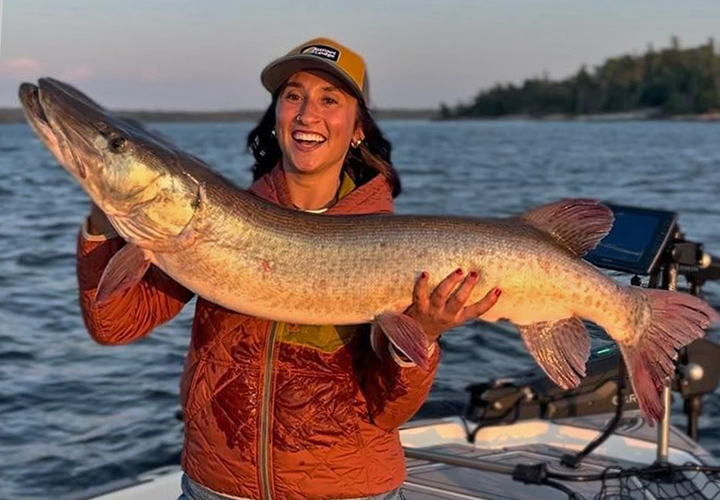 Walleyes and saugers are also being caught in the Rainy River, especially in deeper holes and around current breaks. Don’t overlook the river’s strong smallmouth bass population either — there are some real footballs to be caught.
Walleyes and saugers are also being caught in the Rainy River, especially in deeper holes and around current breaks. Don’t overlook the river’s strong smallmouth bass population either — there are some real footballs to be caught.
There are some great summer options for fishing the 42 miles of navigable Rainy River. It is also a nice option if the wind blows or you want a change of scenery.
Up at the Northwest Angle, most anglers are still jigging around the thousands of islands in 15 to 30 feet of water. As the summer progresses, bottom bouncers paired with crawler harnesses become even more effective, letting anglers cover ground across flats and along edges where mud meets structure.
It’s also muskie season up at the Angle, and fishing is going strong. Anglers are catching and releasing some beautiful fish. Remember, muskies are sensitive predators, so please take extra care when handling and photographing them to ensure a healthy release.
Why Lake of the Woods Shines in Summer. Across much of the walleye belt, summer can bring tough fishing. Weed growth, millions of young-of-the-year perch and other baitfish, and heavy boat traffic make them harder to catch. But that’s not the case on Lake of the Woods. The massive mud basin, countless reefs and rock piles, and sheer abundance of walleyes keep the bite consistent all summer long." — Lake of the Woods Tourism, (800) 382-FISH
 Reader Comments July 8, 2025 "Frustrated By DNR Walleye Survey"
Reader Comments July 8, 2025 "Frustrated By DNR Walleye Survey"
"On 7-7-25 Brandon Flaata wrote, "I took the DNR survey regarding the reduction of the daily and possession limits. I have to say I am very disappointed in the survey, as in my opinion it is very skewed. (It is set up) so the majority of answers could allow the DNR to justify reducing the limit.
Some of my major concerns: Why wasn't there any research data to read before taking the survey to be able to better react to why they are proposing the solution (there was some high level explanation, but detailed information was omitted)? Why weren't there any questions around other possible solutions, like statewide slot limits, so people could react to other ideas that have been presented? Why was there no research presented explaining how existing/recent reductions, slot limits or other special regulations have impacted fisheries?
I'm frustrated as it feels like this was a way to let people think they have a say in the matter, but they aren't going to listen and do whatever they want in the end." — Brandon Flaata
 Sundin: Brandon, like you, there have been several others, including some highly knowledgeable fisheries biologists making the same observation about the survey's construction. By now, it should be fairly obvious that the high ranking DNR Fisheries Management does not view this regulation change as a response to scientific research. Rather, they view it as a "proactive" regulation aimed at, in their view, preventing future declines in the quality of walleye fishing opportunities in Minnesota.
Sundin: Brandon, like you, there have been several others, including some highly knowledgeable fisheries biologists making the same observation about the survey's construction. By now, it should be fairly obvious that the high ranking DNR Fisheries Management does not view this regulation change as a response to scientific research. Rather, they view it as a "proactive" regulation aimed at, in their view, preventing future declines in the quality of walleye fishing opportunities in Minnesota.
It is obvious too that whether the regulation will actually result in any improvement is irrelevant. For them, it is the adoption of the rule, not the effectiveness of it that’s important. We can see by their actions that this philosophy is what drives their narrative. So, we should not be surprised that their survey, titled "Walleye and Sauger Limit for Inland Waters" would be skewed toward enactment of the rule change.
Last week, I answered the survey questions myself, and I found that the survey does offer participants an opportunity to provide individual comments. For me, this was more valuable than answering the questions themselves. So, despite the ‘pre-ordained” sensation the survey questions conjure up, it is still worthwhile to respond with answers in the comments sections.
One additional thought for folks who aren’t “survey takers” or do not believe that their input is valued. The survey provided by the DNR is NOT the only way to provide input. I find it very easy to reach my area fisheries supervisor, along with a variety of the fisheries field staff in my region. These folks are easy to find using the state’s website, and you should contact them directly with your concerns and comments. Some may not believe me, but I think that the regional fisheries folks and their field staff are very responsive and considerate.
Obviously, we’ll be following the debate closely over the next 5 weeks, and will provide updates frequently. In the meantime, let your opinions be known here, they are both valued and appreciated. ![]() — Jeff Sundin, The Early Bird Fishing Guide Office Cell Call or Text 218-245-9858
— Jeff Sundin, The Early Bird Fishing Guide Office Cell Call or Text 218-245-9858
 Reader Comments July 8, 2025 "Ethics: Explaining the Explain-Able?"
Reader Comments July 8, 2025 "Ethics: Explaining the Explain-Able?"
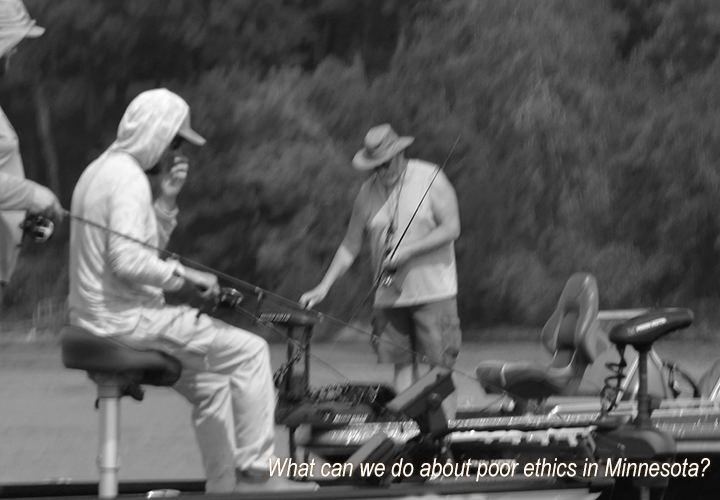 7-1-25 Matt Saigeon wrote, "Jeff, I live close to Sand Lake just north of Bowstring Lake. We've been here for 7 years now and I fish (many of the local waters) as well as the occasional trip to Upper Red Lake. I'm a regular follower of your fish report and honestly, your "wiggle worming" technique has greatly improved my success at catching walleyes. I greatly value your advice.
7-1-25 Matt Saigeon wrote, "Jeff, I live close to Sand Lake just north of Bowstring Lake. We've been here for 7 years now and I fish (many of the local waters) as well as the occasional trip to Upper Red Lake. I'm a regular follower of your fish report and honestly, your "wiggle worming" technique has greatly improved my success at catching walleyes. I greatly value your advice.
I have one observation and am wondering what your take on it is. I wouldn't say that I'm an expert fisherman, but generally speaking, I don't have much trouble finding and catching walleyes. What I have noticed in recent years is that if I catch and land a fish on the lakes around here, and if there are boats close enough to SEE me catch the fish, there is about a 90% chance that those boats will quickly come over to my particular spot and begin to fish right next to me. In many cases, they will get within casting distance of my boat. I had a case on Bowstring earlier this year where I saw only one other boat on the entire lake, I caught a fish and within minutes, the other boat was trolling behind me so closely that they were positioned over top of my bait.
This happens to me almost every time I'm fishing on these lakes up here. On Sand Lake recently, I was fishing a mid-lake hump and there was another boat trolling the shoreline several hundred yards away. I caught a walleye and the other boat immediately raced over and he was trolling circles around my boat at no more than 15 yards away from me. (My perception) is that when this happens, the other boat is usually a big, expensive boat.
I fish from a modest, alumacraft. Nothing fancy, but very effective. I have several theories about why this happens so often, but I'd like to hear your take on it. I'm sure, since you fish the same waters, that this also happens to you. Personally, I would never do this to another fisherman because I value privacy and fishing in peace and quiet. This has become so commonplace that I sometimes find myself avoiding fishing because I just don't want to deal with it anymore. Thank you and I appreciate your comments. — Matt Saigeon"
 Sundin: Matt, I’m both sorry and disappointed that some of our fellow anglers have behaved so disrespectfully. I’m afraid that like you, I too see frequent examples of what can best be described as poor sportsmanship on the lakes. I wish that I could offer a snap-of-the-fingers solution that would make the lakes more peaceful and enjoyable for everyone.
Sundin: Matt, I’m both sorry and disappointed that some of our fellow anglers have behaved so disrespectfully. I’m afraid that like you, I too see frequent examples of what can best be described as poor sportsmanship on the lakes. I wish that I could offer a snap-of-the-fingers solution that would make the lakes more peaceful and enjoyable for everyone.
No doubt, there are a handful of people that are just plain rude. But for me, I find it helpful to remember that most people who come uncomfortably close are simply trying to catch a fish. Sometimes they don’t know what to do, or where to go and when they see anybody bring in a fish, it gives them a spot in which to focus their attention. I try to put myself in their shoes and give them some consideration by moving to a different location.
On June 30, 2025, I wrote about me taking a class, and passing the Minnesota Boater Certification course. At the time, I thought about boating ethics, and how that course could have placed a lot more emphasis on boating and angling ethics. Truthfully, nobody teaches anybody anything about ethics before they buy a boat and head toward the lakes. In my opinion, this needs to change.
When I wrote about the boating certificate I obtained, I mentioned that because of my age, I would never have been required to take the course or pass the test. But, if it was left up to me, boaters of any age, operating watercraft of any type and on every lake in Minnesota would be required to obtain a boating certification. For me, the certification would not only require passing the current test but would also include an equally stringent “boater ethics” section. Some of which covers the simple problems of where, and when it is acceptable to be near other boaters.
Finally, Matt, I appreciate you bringing this topic into the light and I’m guessing that we’ll be hearing a lot more about angling ethics in the coming months. So. I will add more thoughts, and a couple of firsthand stories as time allows. For now, it's on all of us to do our best, set a good example and try to correct the problems through supportive, education based peer pressure.
 Wired2Fish July 7, 2025 "How to Frog the Thick Stuff with Cal Lane"
Wired2Fish July 7, 2025 "How to Frog the Thick Stuff with Cal Lane"
 "In this video, professional angler Cal Lane demonstrates an efficient and high-impact approach to frogging thick vegetation. With a focus on surface mats and heavy grass cover, Lane shares real-time strategy adjustments, target areas, and bite-triggering techniques. Each cast is designed to draw strikes from bass holding beneath dense cover, resulting in aggressive topwater action.
"In this video, professional angler Cal Lane demonstrates an efficient and high-impact approach to frogging thick vegetation. With a focus on surface mats and heavy grass cover, Lane shares real-time strategy adjustments, target areas, and bite-triggering techniques. Each cast is designed to draw strikes from bass holding beneath dense cover, resulting in aggressive topwater action.
Targeting Mats in Heavy Vegetation: Frogging success often comes down to finding the right kind of vegetation. Lane looks for mats that form a solid layer over the surface, where fish can sit comfortably just under the cover. When these mats mix with open patches or thinner grass nearby, they ..." View Video to Learn More >> How to Frog the Thick Stuff with Cal Lane
 July 6, 2025 "Loving The Love-Able" “What I Do, and Do Not, Love About Being A Fishing Guide”
July 6, 2025 "Loving The Love-Able" “What I Do, and Do Not, Love About Being A Fishing Guide”
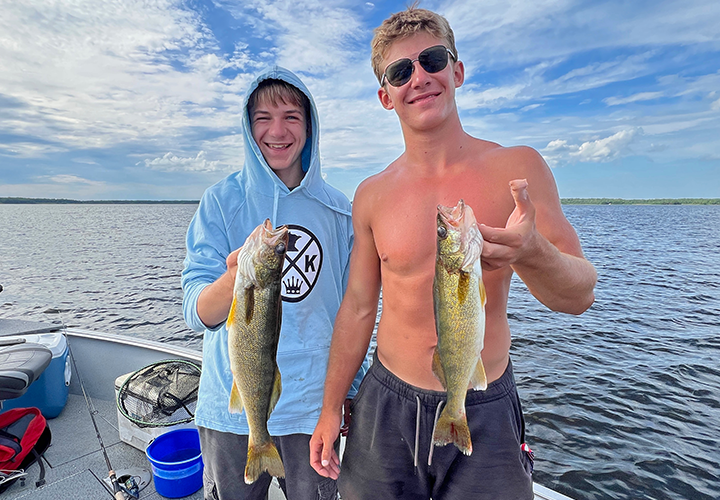 If there ever was a week that revealed the contrast between what I love, and what I don’t love about fishing; it was this past one. There were some easy fishing days, but there were some tough ones too. There were some love-able people, but there were some un-love-able ones too. And there was some gorgeous weather, but on the other hand, some uncomfortable ones as well.
If there ever was a week that revealed the contrast between what I love, and what I don’t love about fishing; it was this past one. There were some easy fishing days, but there were some tough ones too. There were some love-able people, but there were some un-love-able ones too. And there was some gorgeous weather, but on the other hand, some uncomfortable ones as well.
The common thread running through my most favorite days? Families. Moms, dads and kids, sometimes all together, sometimes just the kids, sometimes just the parents, but always, everybody together at the end of the day. There’s a certain dynamic that doesn’t come any other way, family fishing is supportive, not self-centered. Almost always, people are happy when they see their family members having fun, happiness isn’t performative, or dependent on one’s individual success.
The common thread running through my least favorite days? Elitism. Individuals who regard one species of fish, or one style of fishing, or one brand of anything, as “better” than any other.
I don’t dwell on the negative, but I will say that I was taken aback by one person in particular. Who when learning the wiggle worming presentation and catching a wide array of fish species, became noticeably upset by attention from any fish that was not a walleye. It is perfectly fine to target walleyes, but if you want to single them out, it can’t always happen. This is particularly true when you select a lake that has more of everything else, except walleyes. There are times when catching the mixed bag, and sorting through what this person called “garbage fish”, is the only option.
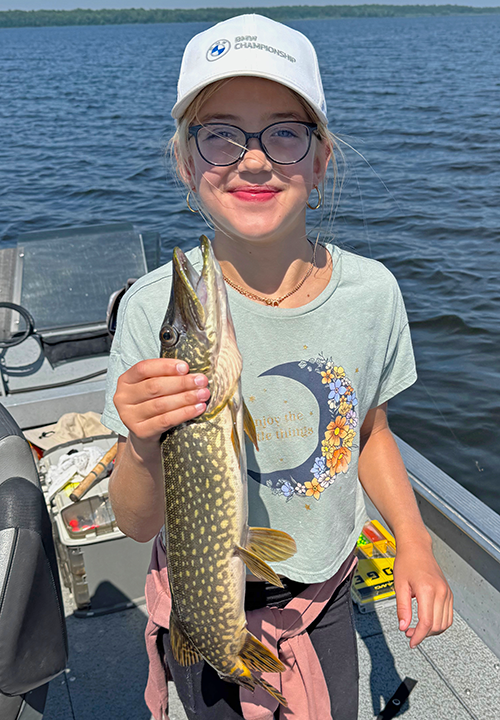 Back to families, and why I love fishing with them is that the so-called “garbage fish” are appreciated, even loved by most. Smallmouth bass, largemouth bass, crappies, sunfish and northern pike are not always harvested, but are usually appreciated for their ability to keep the level of action steady. Sometimes, part of the by-catch IS harvested as well, and that adds to the fun. For me, there’s a recipe for every species of fish that elevates them to all star status as table fare. Admittedly, I haven’t done too well cooking bullheads, but some folks do, and I wish they’d share their secrets with me.
Back to families, and why I love fishing with them is that the so-called “garbage fish” are appreciated, even loved by most. Smallmouth bass, largemouth bass, crappies, sunfish and northern pike are not always harvested, but are usually appreciated for their ability to keep the level of action steady. Sometimes, part of the by-catch IS harvested as well, and that adds to the fun. For me, there’s a recipe for every species of fish that elevates them to all star status as table fare. Admittedly, I haven’t done too well cooking bullheads, but some folks do, and I wish they’d share their secrets with me.
Anyway, a day of catching fish, no matter which fish they are, and what we do with them, goes faster than a day of grinding away to catch a handful of walleyes. If I told you we brought in 9 or 10 walleyes on a given day, it may or may not impress you. But if I mentioned catching 100 fish, and then added that some of those fish happened to be walleyes, then you might be more appreciative.
Last week, I mentioned that we had begun seeing the development of a mixed-bag, action bite. At the time, trolling spinners, tipped with minnows was producing a mix of pike, perch and walleyes. Then, water temperatures were just above 70 degrees and this week, the sunshine has warmed surface temperatures into the mid-70s. Now the fish metabolism is running even higher, and in response, action ramped up even more. Now we’re catching the full-scale mixture of every fish species in the lakes. It’s becoming common to get 7 or 8 species of fish on most trips.
Even clear water lakes are warming, yesterday, on Pokegama Lake in Grand Rapids, we swam in 76-degree water. It wasn’t exactly a “fishing trip” but we did troll for a while as we waited for the fireworks. There was just enough time to figure out that the mixed bag bite is kicking in there as well. My daughter, Annalee and her family, Austin and Audrey Jones helped spin up some crappies and sunfish from the weeds. I don’t recall anybody being upset that we didn’t catch a walleye. In fact, they looked pretty happy with the fish they did catch, don’t you think?
Rest assured, I love catching walleyes just as much as anybody and without them, I’d be out of business. There are times though that catching walleye, and only walleye, absent the presence of so-called “garbage-fish” like smallmouth bass and sunfish, is not a realistic goal.
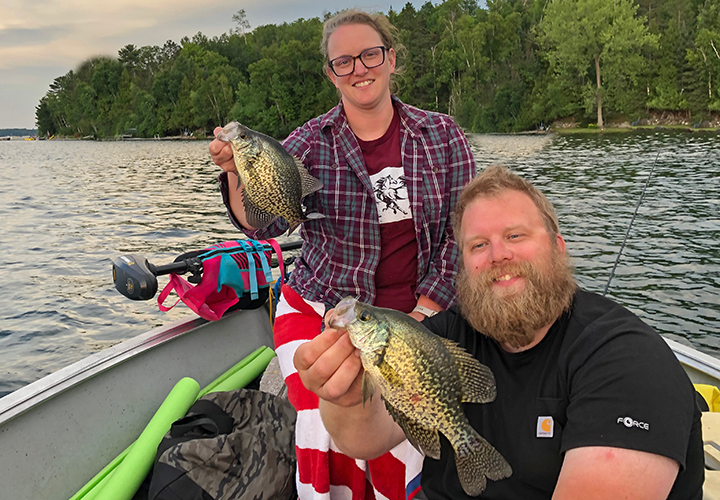 During mid-summer, walleyes have lots of feeding options, so they can be particular about what they eat, and when they eat it. Add to that that, other gamefish are more active than they are duing the cool water periods and often get to your bait faster than walleyes do. So, walleyes, while present in the mix, are often overshadowed and outcompeted; the ratio of them to other gamefish is diminished.
During mid-summer, walleyes have lots of feeding options, so they can be particular about what they eat, and when they eat it. Add to that that, other gamefish are more active than they are duing the cool water periods and often get to your bait faster than walleyes do. So, walleyes, while present in the mix, are often overshadowed and outcompeted; the ratio of them to other gamefish is diminished.
The solution? Avoid multi-species lakes and only fish lakes where the only predators are walleyes. Upper Red Lake for example is one place where the odds are higher for walleyes than they are for most other species. Alternatively, select lakes that have some mixed species, but only have populations of fish that you enjoy catching. If you research lakes in north central Minnesota, you can find a wide range of gamefish blends. Any lake with the highest walleye population, and the lowest populations of competing predators could be an option.
Okay, with the Independence Day holiday, and the early season walleye fishing rush behind me, I’ll be enjoying a more relaxed pace this week. For me, discovering new (to me) places to wet a line is the priority. What I hope to discover, are a few more lakes where the “mixed-bag-action-bite” shows potential for some upcoming family fishing trips during the rest of July, and into August.
Speaking of a more relaxed pace, I do still have a handful of open dates available during the summer. If you’ve been thinking about getting the kids out for an adventure on the lake, let me know, I may have the right day available for you.
Before I wrap up for this morning, I do want to take a minute to remind you that the MN DNR Fisheries Chief, Brad Parsons, has presented the formal announcement to move ahead with the much-anticipated Walleye Limit Reduction plan. Slated to take effect for the May 2027 walleye fishing opener, the rule is set to reduce Minnesota’s Walleye Possession Limit of walleyes from 6 fish, down to 4 fish. Anglers will be allowed, if enacted, to have in their possession 4 legally obtained walleyes.
Contrary to public perception, there is no provision now, nor will there be under this rule, any multiple of the so-called “daily bag limit”. The daily bag limit IS your possession limit. So, whether you have 4 walleyes in your freezer, at your cabin, or in a shoe box under your bed, you cannot legally harvest another walleye from ANY LAKE in Minnesota until you consume the ones you already have.
 I know, thousands of anglers simply disregard that rule every season. They catch fish and take some of them home every time they go fishing. They believe that as long as they stay within the so-called “legal daily bag limit” that they’re good to go. That’s great for local anglers, folks who can hide their fish at home, or at their cabin. But travelers, both resident and non-resident anglers alike have no choice but to carry their catch, in their “POSSESSION” when they travel home from the lake. For them, they are completely exposed and subject to being checked by the game warden at any time. That’s why the statewide 4 walleye possession limit rule is a big deal to me. It discriminates against tourism, and favors local anglers who can and do, keep more than their fair share of the total harvest.
I know, thousands of anglers simply disregard that rule every season. They catch fish and take some of them home every time they go fishing. They believe that as long as they stay within the so-called “legal daily bag limit” that they’re good to go. That’s great for local anglers, folks who can hide their fish at home, or at their cabin. But travelers, both resident and non-resident anglers alike have no choice but to carry their catch, in their “POSSESSION” when they travel home from the lake. For them, they are completely exposed and subject to being checked by the game warden at any time. That’s why the statewide 4 walleye possession limit rule is a big deal to me. It discriminates against tourism, and favors local anglers who can and do, keep more than their fair share of the total harvest.
In my opinion, the daily limit could be set at any random number, and I’d still be happy. You could limit me to 1 fish, and I’d be satisfied, so long as my possession limit remains at the present level, 6 walleyes in my possession. You’ve read before, or maybe not, all of the reasons why I believe the 4 fish daily limit won’t fix anything. Fisheries biologists have said repeatedly that the cuts would have to be much more dramatic to impact the overall statewide harvest. So, supporting the 4-walleye limit is unlikely to result in any benefit to you, or to the walleyes, or to the future of fishing.
Is the walleye reduction rule a done deal? No, it's success, or failure, will depend on how the public responds to the proposal. First, there is a public comment period in which citizens may present their opinions to MN DNR Fisheries staff. One way to participate is to answer questions in a MN DNR provided survey called "Walleye and Sauger Limit for Inland Waters"
Another way to present your opinions is to share them here, with your fellow FishRapper readers. We’ll publish, with your permission, comments on both sides of the issue, even the ones thay we don’t agree with. So, make your best case, if you support the rule, tell us why and if not, let us know that too. Either way, your opinion matters, and I wholeheartedly encourage you to take advantage of this opportunity to influence the future of walleye fishing in Minnesota. ![]() — Jeff Sundin, The Early Bird Fishing Guide Office Cell Call or Text 218-245-9858 or Email on Facebook on X Photo >> Decker Hastings • Owen Cheatham • Claire Cheatham • Annalee Austin Jones • Owen Blaine Cheatham
— Jeff Sundin, The Early Bird Fishing Guide Office Cell Call or Text 218-245-9858 or Email on Facebook on X Photo >> Decker Hastings • Owen Cheatham • Claire Cheatham • Annalee Austin Jones • Owen Blaine Cheatham
 Cutfoot Sioux, Lake Winnie Memorial Day Fishing Report July 3, 2025
Cutfoot Sioux, Lake Winnie Memorial Day Fishing Report July 3, 2025
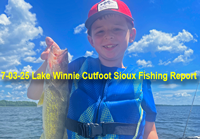 "We are heading into the Independence Day holiday weekend on a warm note. And as the sunshine warms the waters of Lake Winnie and Cutfoot Sioux, productive summertime fishing patterns for walleye, perch and panfish have taken hold.
"We are heading into the Independence Day holiday weekend on a warm note. And as the sunshine warms the waters of Lake Winnie and Cutfoot Sioux, productive summertime fishing patterns for walleye, perch and panfish have taken hold.
Surface temperatures on the big lake range from 71 to 73 degrees, and back bays with darker, calmer waters are running warmer, 74 to 76 degrees in some areas. Vegetation is maturing too, cabbage, coontail and many of the “pondweed” varieties are green and thick. Wild rice beds are starting to stand tall above the surface, and bulrushes are green and mature too. All plants, no matter where they grow, provide cover habitat for fish of all species, including the most popular game fish pursued by our guests.
During the warmup, insect hatches began emerging and hatches of many insects continue today. Fishing for walleyes during any “bug hatch” can be challenging, but in many ways can be rewarding too. Finding the areas where maturing insect larvae is most likely to emerge will lead anglers to success. Where maturing larvae exists, minnows, small gamefish and predators will be nearby; all participating in the “summer peak” food chain cycle.
Marl, the mixture of semi-soft, clay, sand and shell pieces are prime real estate for bloodworms, fish flies and mayfly larvae breeding grounds. Marl can be located whem we ..." Read >> Bowen Lodge Lake Winnie Fishing Report
 Ely Area, Arrowhead Outdoors Fishing Report July 2, 2025
Ely Area, Arrowhead Outdoors Fishing Report July 2, 2025
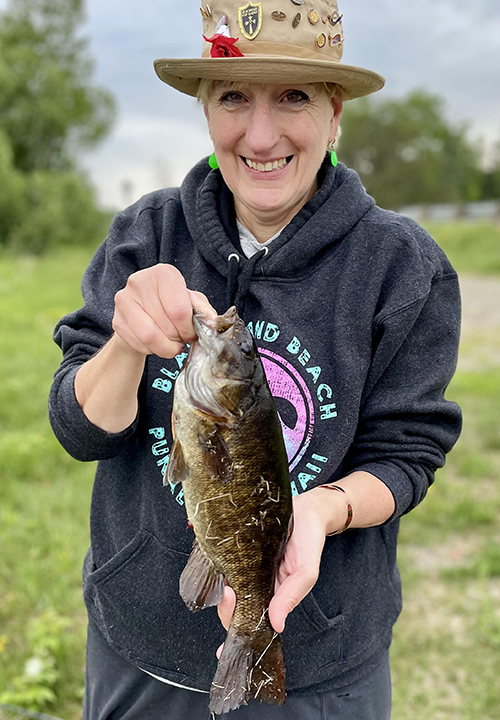 "Walleye - Walleye reports have walleyes sliding out a little deeper. Majority of walleye reports this last week has angler finding walleyes in 8 to 16 feet of water now. Anglers have been pulling spinner rigs, tipped with crawlers, along weedlines, transitions area along points and out over sunken islands. Gold, perch and blue spinner blades have been popular this last week. Reports of shallow water walleyes remain. Here anglers are catching walleye with soft plastics fished on a 1/8 or 1/4oz jig, over rocky shorelines. Jig and half a crawler has also been worth noting here.
"Walleye - Walleye reports have walleyes sliding out a little deeper. Majority of walleye reports this last week has angler finding walleyes in 8 to 16 feet of water now. Anglers have been pulling spinner rigs, tipped with crawlers, along weedlines, transitions area along points and out over sunken islands. Gold, perch and blue spinner blades have been popular this last week. Reports of shallow water walleyes remain. Here anglers are catching walleye with soft plastics fished on a 1/8 or 1/4oz jig, over rocky shorelines. Jig and half a crawler has also been worth noting here.
Panfish - Crappies have been snapping in shallow water in and around lily pads this last week. Thick lily pad beds are no good. Scattered lily pads have been the best for crappies. Anglers have been casting small jig and twisters, crappie minnows under a bobber to these lily pads, to catch crappies. Sunfish remain shallow and are being caught back in pencil reed beds and weedbeds. Wax worms, green crawlers and angleworms, fished under a bobber have been very effective here.
Smallmouth Bass - The once super hot topwater bite has been cooling off to mainly early morning for the best bite (before 9am). Once the sun gets up anglers have been having luck with square bills, wacky worms, chatterbaits and spinnerbaits. Rocky shorelines with downed trees, large flats, out around islands and rivers are all holding active smallies. White, crawfish colors and green pumpkin have been hot colors this last week.
Stream Trout - Area Stream Trout lakes remain popular for good reason. Rainbow trout have been snapping! Limits of rainbows are being caught trolling small minnow baits or small trolling spoons over deep water. Good rule of thumb is the brighter the better as far as colors go. Anglers fishing from shore have been having really good luck casting a 2 inch white twister, small spoons and the tried and true nightcrawler floated under a bobber.
Northern Pike - Pike anglers have been catching good numbers of quality pike this last week. Anglers have been throwing spoons in and around weedbeds for very consistent action. Anglers targeting larger pike have been trolling large spinnerbaits, large minnow baits and large soft plastic baits along weedlines, river mouths and mouths of shallow bays. Best depth for the bigger pike has been 8-14 feet of water.
Lake Trout - Lake Trout anglers have been reporting that lakers are slowly going deeper as surface water temps warm. Anglers have been reporting that they are catching lakers from 30 to 80 feet of water now. Many anglers have been trolling large trolling spoons, with down riggers, over deep water to find active lakers. Anglers fishing from a canoe have vertically jigging large bucktails and tubes over deep water. Red/white, blue/white and solid chartreuse have been popular colors for tubes or bucktails." — Arrowhead Outdoors, 218-365-5358
 July 1, 2025 "News release: Public input sought on reducing statewide walleye limit from six to four"
July 1, 2025 "News release: Public input sought on reducing statewide walleye limit from six to four"
 If you’re a believer in reducing Minnesota’s walleye possession limit from 6 fish, down to 4 fish, then this is your happy day! The Minnesota DNR Fisheries Office released the much-anticipated formal announcement yesterday.
If you’re a believer in reducing Minnesota’s walleye possession limit from 6 fish, down to 4 fish, then this is your happy day! The Minnesota DNR Fisheries Office released the much-anticipated formal announcement yesterday.
MN DNR, “Changes in lake habitat, ecology and conditions coupled with technological advances in fishing gear and methods are prompting the Minnesota Department of Natural Resources to seek public input on a possible reduction in the statewide walleye possession limit from six to four fish.
If enacted via a rulemaking process, the change would not become effective until May 2027.
“We consider this a proactive step to maintain quality walleye fishing,” said Brad Parsons, DNR fisheries section manager. “This regulation has been in place since 1956, and conditions in Minnesota’s lakes have, and continue to, change. Our consideration of a walleye limit reduction is a wise management response to what’s happening.”
People can comment from now until …” Read Full Article >> July 1, 2025 Public Input Sought, Reducing Statewide Walleye Limit
 Lake of the Woods, LOW Tourism July 1, 2025
Lake of the Woods, LOW Tourism July 1, 2025
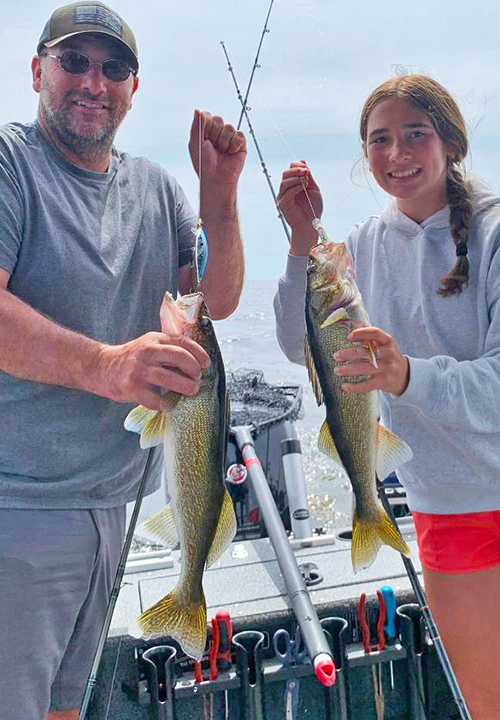 "Fishing continues to be outstanding on Lake of the Woods. Whether you’re jigging, pulling spinners, or trolling crankbaits, anglers are enjoying steady action and taking home plenty of walleyes and saugers.
"Fishing continues to be outstanding on Lake of the Woods. Whether you’re jigging, pulling spinners, or trolling crankbaits, anglers are enjoying steady action and taking home plenty of walleyes and saugers.
On the South Shore, there are good numbers of walleyes now gravitating to the deep mud basin regions. This time of year, it’s common to see bug hatches over the deep mud, which attracts hungry walleyes looking for an easy meal. Fishing anywhere from 27 to 35 feet has been productive.
The jig bite remains strong. Many anglers are still anchoring up or spot-locking and working a jig tipped with a frozen emerald shiner. Hot jig colors this week include orange and chartreuse, gold combined with orange or pink, as well as glow white. Mixing up your colors and letting the fish tell you what they want can really pay off.
Spinners and crawlers are also gaining momentum. Drifting or slowly trolling at 1.0 to 1.25 mph with a 2 to 3 ounce weight or bottom bouncer, a two or three hook harness with a hammered gold blade paired with pink, orange, chartreuse, or glow red or white beads has been very effective. This technique is a great way to cover water and entice walleyes spread out over the basin. Many anglers report catching a mix of walleyes and saugers using this method.
Trolling crankbaits is another excellent option right now. Some anglers are trolling using downriggers to get their lures down to the fish. Others are using leadcore line, snap weights, or a 3 to 4 ounce bottom bouncer paired with a 6-foot monofilament or fluorocarbon leader with a shallow diving crankbait. These setups are helping anglers reach the right depth and keep their baits in the strike zone. The ability to cover lots of water while presenting wobble, vibration, and color makes trolling cranks a very effective way to locate and catch walleyes.
On the Rainy River, reports indicate that the river is still producing some nice walleyes, and it won’t be long until anglers start shifting their attention to sturgeon again. Sturgeon fishing season opens on July 1, 2025 and the river is loaded with these prehistoric giants. If you’re planning a trip in July or August, soaking a few crawlers on a sturgeon rig can give you the chance to hook into one of the biggest fish of your life.
Excellent fishing also continues up at the Northwest Angle. Walleyes are being found from 12 to 24 feet, relating to both mud and structure. The jig and minnow bite remains solid on rock and sand transitions, while other anglers are also pulling spinners or crankbaits along shoreline breaks and over deeper mud areas. This is producing not just walleyes, but also a nice mix of jumbo perch, pike, and even smallmouth bass.
Muskie anglers have been busy with nice numbers of fish and some big ones. Some fish exceeding 53 inches were caught this past week.
Plan Your Trip. Lake of the Woods is living up to its reputation as the Walleye Capital of the World. With a healthy population of walleyes, saugers, pike, smallmouth bass, and soon, sturgeon back in season, now is a perfect time to get out on the water. Whether you’re fishing with your own boat, hiring a guide, or jumping on a charter, the opportunities for success are excellent." — Lake of the Woods Tourism, (800) 382-FISH
 Wired2Fish 2025 "Chasing Bruiser Bluegills: Top Tips and Tactics for Catching Bulls"
Wired2Fish 2025 "Chasing Bruiser Bluegills: Top Tips and Tactics for Catching Bulls"
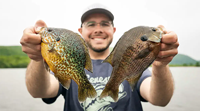 "Growing up, I could always count on a certain fish to make my day. One that was always willing to bite and put a good bend into an ultralight. That species has made its way into the hearts and freezers of millions of Americans nationwide.
"Growing up, I could always count on a certain fish to make my day. One that was always willing to bite and put a good bend into an ultralight. That species has made its way into the hearts and freezers of millions of Americans nationwide.
You likely know it as the bluegill. For fishermen across the country, bluegills are often considered a stepping stone into getting hooked on fishing. They’re in most freshwaters across the country, and growing in abundance around the globe. Plus, panfish are relatively easy to catch.
While bluegills are widespread, finding big bluegills can be a challenge, especially catching them consistently. Standard tactics will work, but there are certain baits and presentations that ..." Read Article to Learn More >> Chasing Bruiser Bluegills: Top Tips and Tactics for Catching Bulls
You Are Invited To Become A Duly Deputized Fishrapper Cub Reporter Too!
 If you've been waiting for a gold engraved invitation to participate in the daily reports, then stop waiting and consider this your own personal invitation.
If you've been waiting for a gold engraved invitation to participate in the daily reports, then stop waiting and consider this your own personal invitation.
Helping your fellow fishermen and women stay abreast of fishing conditions in your area is good for everybody and it's easier than you think! You don't have to write a book, you don't have to share your secret fishing spots and you don't even have to mention your lake. But even a few words about general trends, seasonal patterns and local weather conditions can really help.
Be like me, become a duly deputized "Cub Reporter", it's good for fishing! Contact Us or if you prefer to be "social", Fishing Reports Minnesota, the Facebook counterpart to this page is open to the public, so you can post your own fishing update or just share a photo of a nice catch.
 Wired2Fish 2025 "[VIDEO] How to Spool a Spinning Reel with Braid"
Wired2Fish 2025 "[VIDEO] How to Spool a Spinning Reel with Braid"
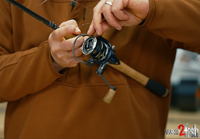 "Spooling a spinning reel the right way isn’t just about loading line—it’s about preventing slip, reducing twist, and maximizing performance. In this step-by-step video, Wired2fish’s own Kyle Peterson breaks down exactly how to spool braid with a mono backing and why each step matters.
"Spooling a spinning reel the right way isn’t just about loading line—it’s about preventing slip, reducing twist, and maximizing performance. In this step-by-step video, Wired2fish’s own Kyle Peterson breaks down exactly how to spool braid with a mono backing and why each step matters.
Why a Mono Backing is Essential: Braid lacks stretch and grip, which means it can slip around the arbor under tension. To prevent this, Peterson starts by adding mono as backing. The mono grips the spool better, creating a secure base layer that locks the braid in place.
Choosing Mono Based on Arbor Size: The size of a reel’s arbor determines which mono line works best. A smaller arbor calls for lighter, thinner mono, while a larger arbor can support heavier mono. Peterson uses 8-pound mono for his setup, but stresses the importance of matching the backing to the reel size to avoid bulking.
Quick, Effective Knots for Reliability: Rather than tying complex knots, Peterson uses a ..." View Video to Learn More >> How to Spool a Spinning Reel with Braid